MITIGATING THE URBAN HEAT ISLAND EFFECT: The Thermal Performance of Shade-Tree Planting in Downtown Los Angeles
Abstract
:1. Introduction
2. Materials and Methods
2.1. Establish a Base Urban Model
2.1.1. Build the Modeling in ENVI-met
2.1.2. Input Climate Data into ENVI-met
2.1.3. Research Questions
- Research question 1: Analyze how much the new tree scheme cools the average UTCI of a sidewalk area compared to existing conditions in study area by adjusting the tree positions while keeping the number and species unchanged (Table 1).
- Research question 2: Identify the months when trees provide greater or smaller benefits in terms of cooling effect, as well as the times when they potentially exert a negative impact.
2.2. ENVI-met Accuracy Verification
2.3. Preliminary Study
2.3.1. Date Analysis
2.3.2. Building Shade Analysis
2.3.3. Transpiration Analysis
2.3.4. Tree Location Analysis
2.3.5. Tree Spacing Analysis
2.4. Numeric Techniques
2.4.1. Monthly Average Climate Day Method
2.4.2. Pixel-Counting Method
2.5. Full-Site Study
3. Results (Preliminary Studies)
3.1. Date Comparison (No Tree Compared with One Tree)
3.1.1. Hottest Day Comparison by Date Factor
3.1.2. Coldest Day Comparison by Date Factor
3.1.3. Graph of Hottest and Coldest Day Comparison
3.1.4. Graph of Each Month Comparison
3.2. Building Shade Comparison
3.2.1. Hottest Day Comparison by Building Shade Factor
3.2.2. Coldest Day Comparison by Building Shade Factor
3.2.3. Graph of Cooling Ability Reduction Comparison
3.3. Transpiration
3.3.1. Hottest Day Comparison by Transpiration Factor
3.3.2. Coldest Day Comparison by Transpiration Factor
3.3.3. Transpiration Effect Comparison
3.4. Tree Location Comparison
3.4.1. Hottest Day Comparison by Location Factor
3.4.2. Coldest Day Comparison by Location Factor
3.4.3. Whole-Year Comparison
3.5. Trees’ Spacing Analysis
3.6. Proposed Tree Layout
3.7. Summary of Preliminary Studies
- Time Factor: Trees provide more shade and have greater cooling ability in summer compared to winter.
- Shading: Trees primarily cool through canopy shading, but building shadows can significantly reduce this effect. It is important to maximize tree shade while minimizing overlap with building shadows.
- Transpiration: Tree transpiration also contributes to cooling and is not affected by building shadows. Transpiration effect is more effective during hot weather, but its cooling effect is much weaker than shading and has minimal impact on the thermal environment and human comfort.
- Location: Trees on the south side of a building have the best cooling effect, while those closer to the north side are less effective.
- Canopy Spacing: Trees cool best when their canopies are spaced apart without overlapping.
4. Results (Full-Site Research)
4.1. No Trees vs. Existing Trees vs. New Trees (Hottest Day)
4.1.1. Three Conditions UTCI Comparisons
4.1.2. Pedestrian Area Average Temperature Analysis (12 pm)
4.2. No Trees vs. Existing Trees vs. New Trees (Coldest Day)
4.3. Existing Trees vs. New Trees (Full-Site Monthly Comparison)
4.4. Reduced UTCI Comparisons
4.5. Summary
5. Discussion
5.1. Comparison with Previous Studies
5.2. Implications of the Findings
5.3. Limitations of the Study
- The analysis is entirely based on data obtained from ENVI-met simulations, without conducting field measurements under the same climatic conditions as the simulations. This does not fully account for potential discrepancies between real-world environments and the simulation results.
- The study exclusively used evergreen species and did not analyze the impact of deciduous trees, particularly in areas where they are the primary street trees, and how their leaf loss during winter affects shading. This could limit the applicability of the results to different tree species.
- Some of the findings are only applicable to areas with climates similar to that of Los Angeles and may not be suitable for cities or regions with significantly different climatic conditions.
5.4. Future Research Directions
6. Conclusions
Author Contributions
Funding
Institutional Review Board Statement
Informed Consent Statement
Data Availability Statement
Acknowledgments
Conflicts of Interest
Appendix A



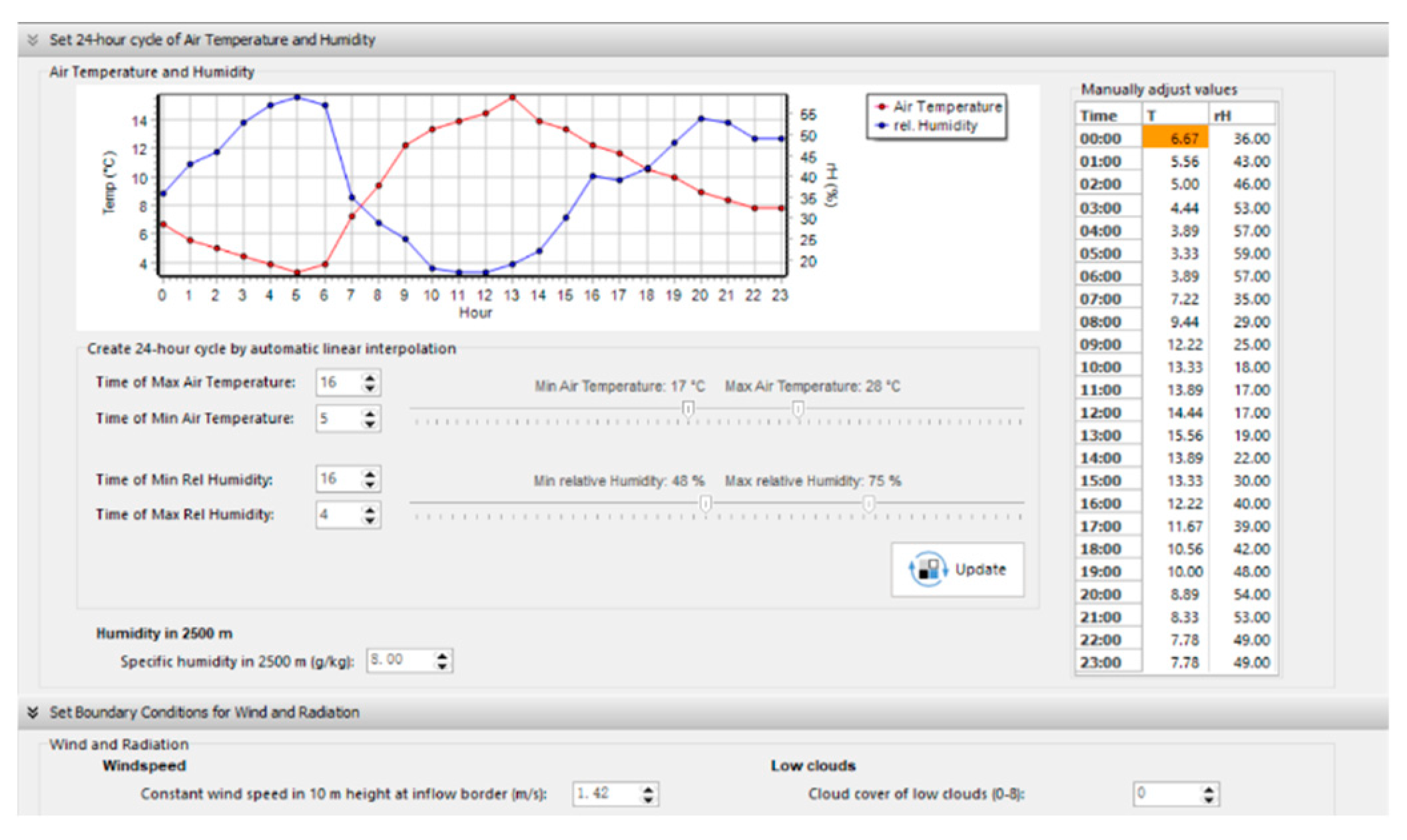
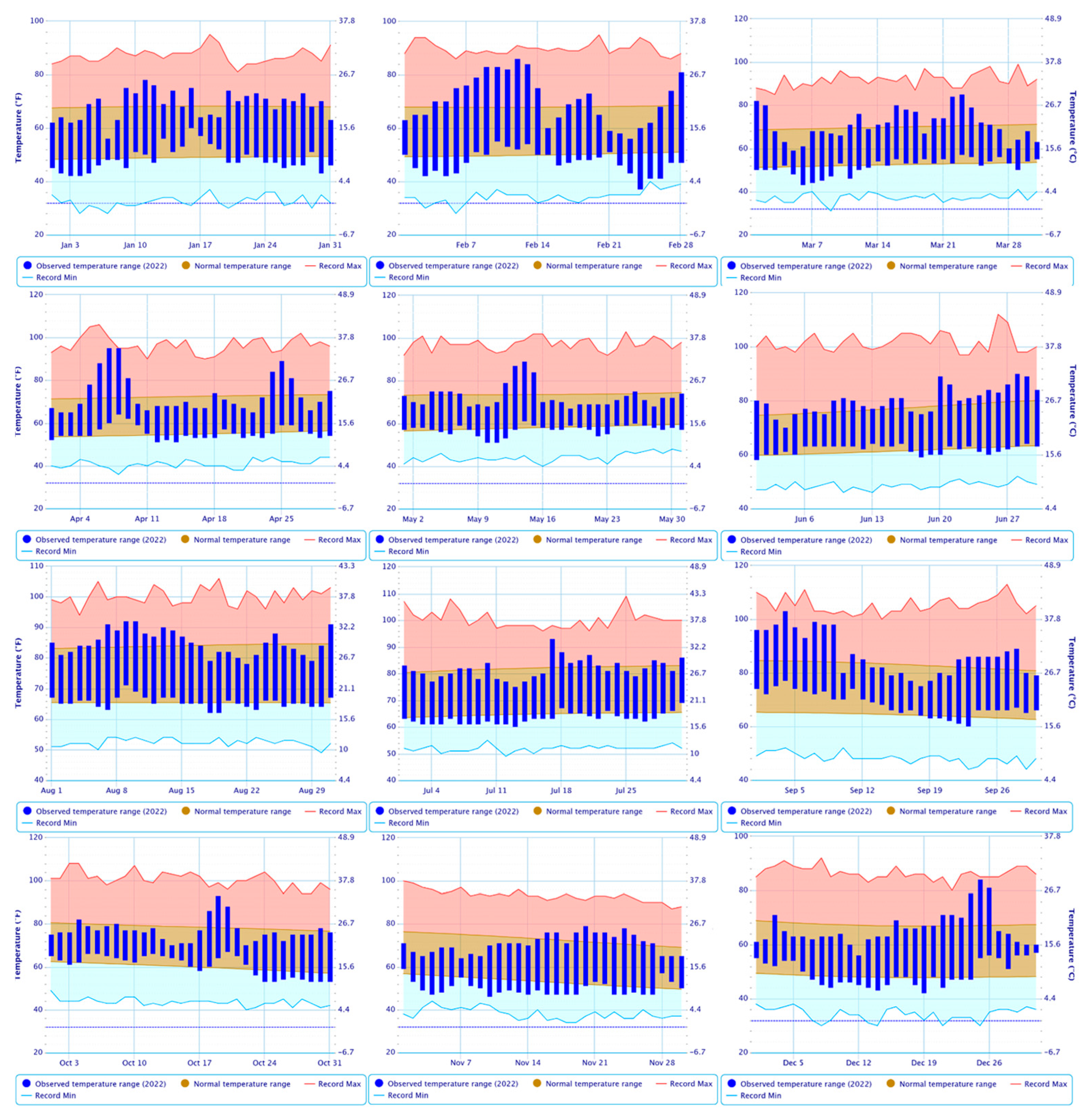




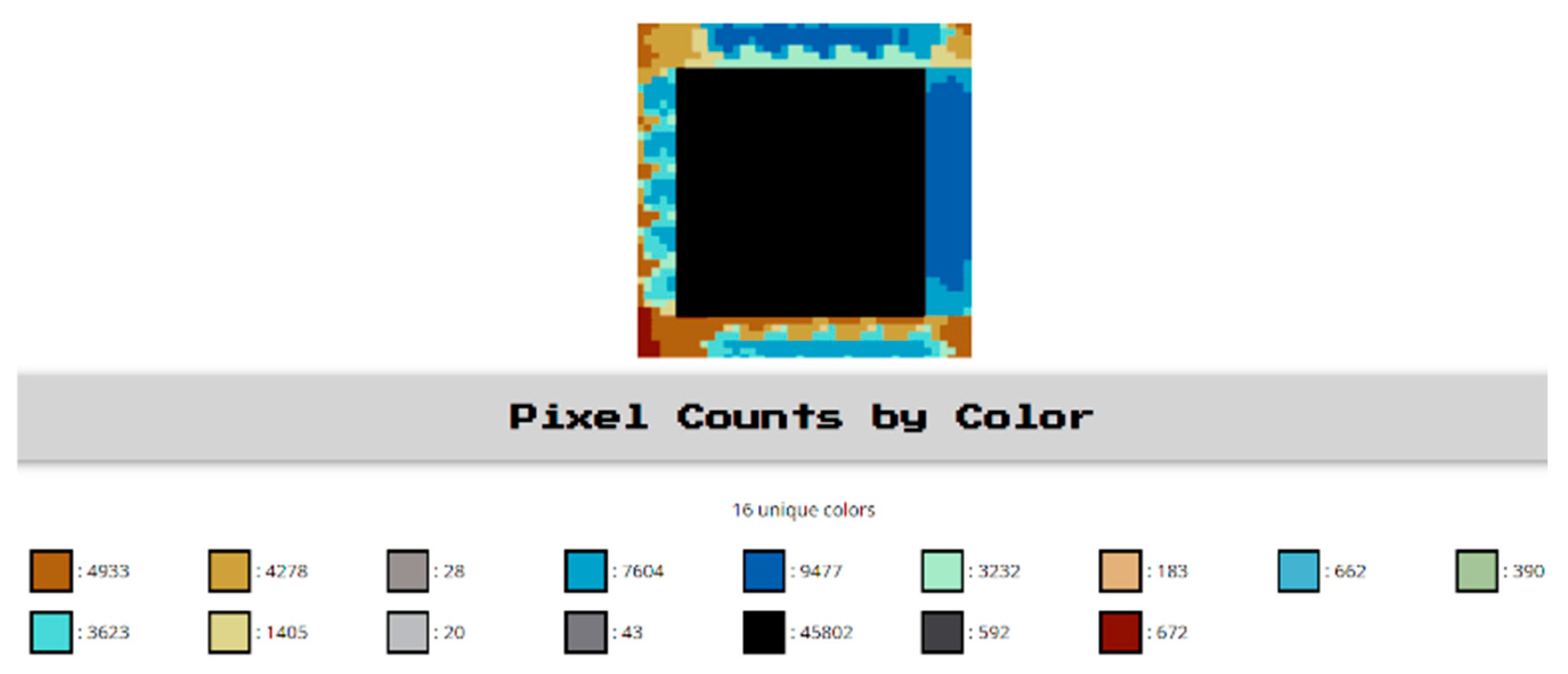
| Temperature (°C) | Number of Pixels | Percentage of the Pixels | Weight Temperature (°C) |
|---|---|---|---|
| 48.16 | 672 | 1.87% | 0.9 |
| 45.93 | 4933 | 13.74% | 6.31 |
| 43.69 | 4278 | 11.92% | 5.21 |
| 42.2 | 1405 | 3.91% | 1.65 |
| 40.71 | 3232 | 9.00% | 3.67 |
| 39.22 | 3632 | 10.12% | 3.97 |
| 37.73 | 662 | 1.84% | 0.7 |
| 36.24 | 7604 | 21.18% | 7.68 |
| 34.75 | 9477 | 26.40% | 9.17 |
| 35,895 | 100.00% | 39.25 |
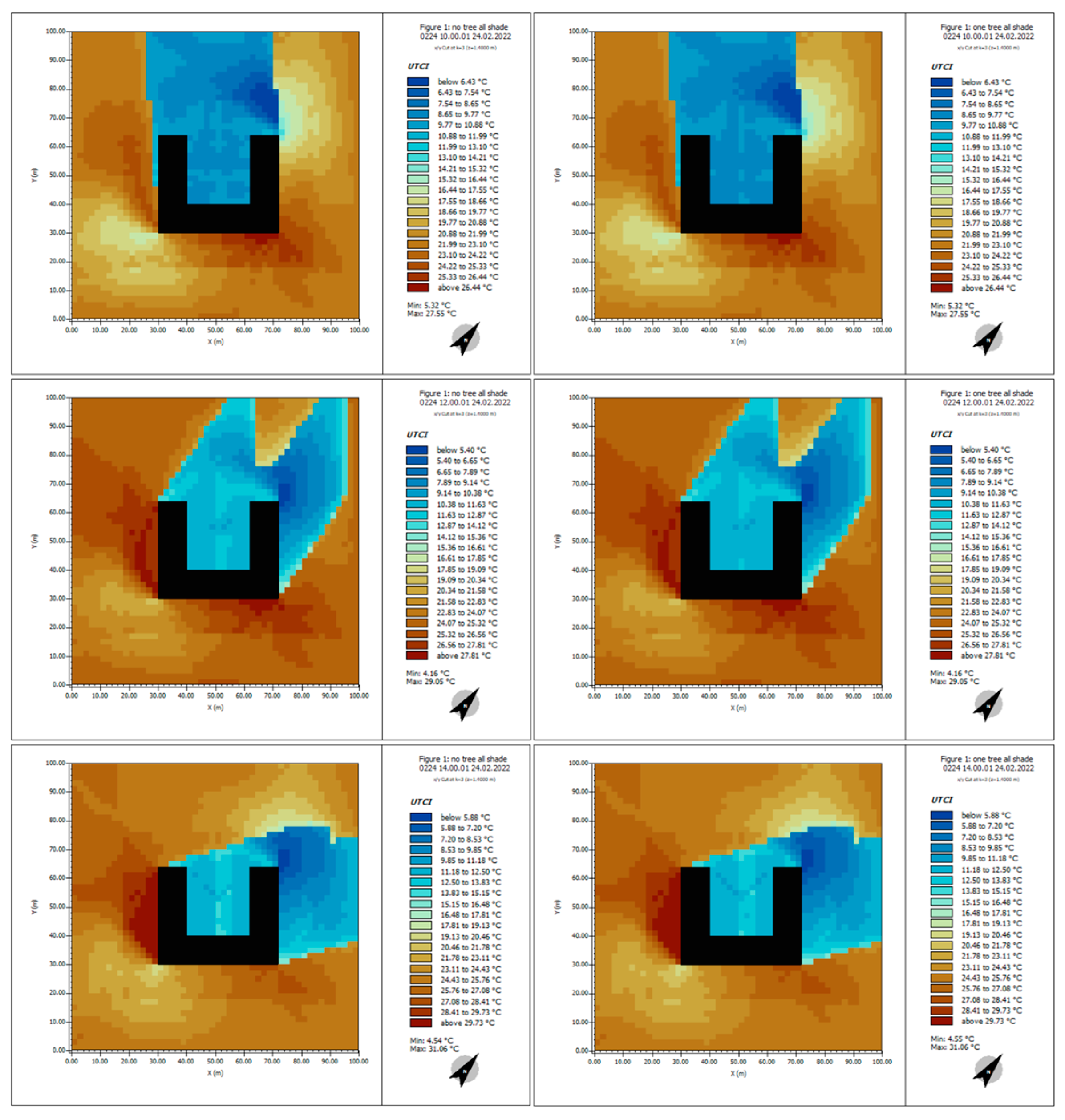


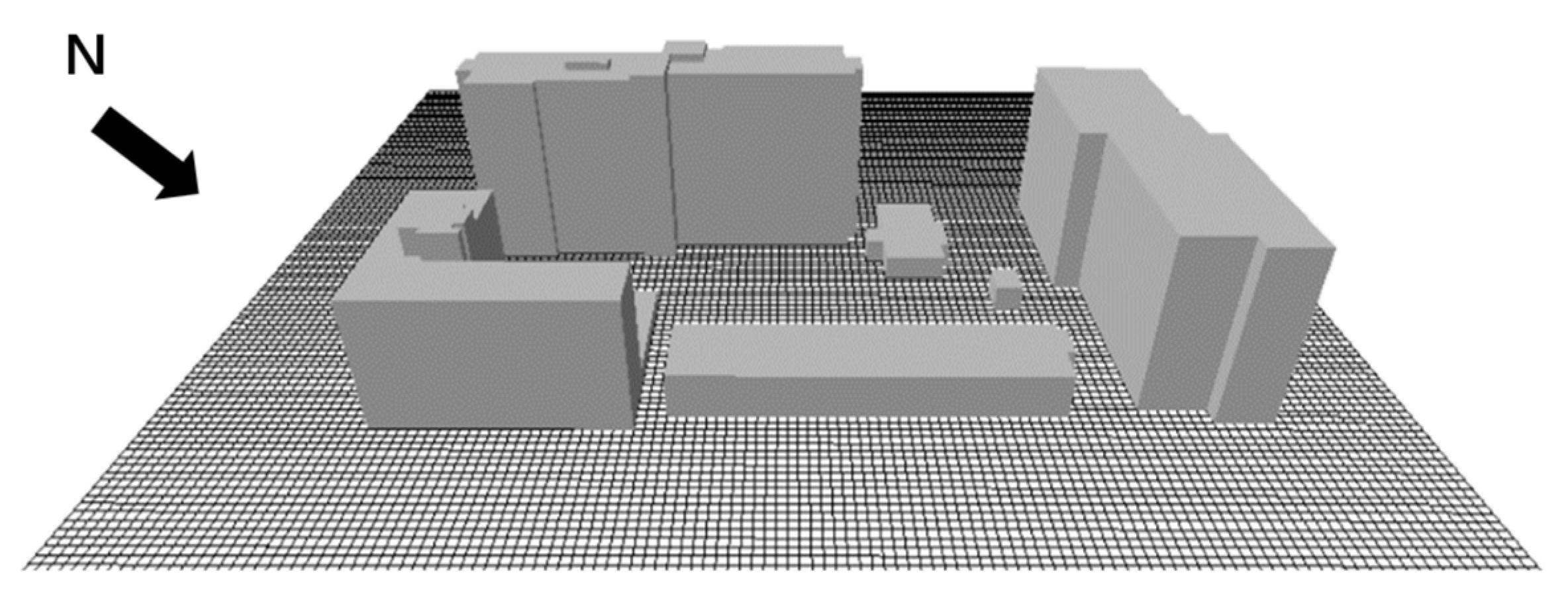

| Temperature (°C) | Number of Pixels | Percentage of the Pixels | Weight Temperature (°C) |
|---|---|---|---|
| 47.1 | 5830 | 16.87% | 7.95 |
| 46 | 560 | 1.62% | 0.75 |
| 45.2 | 15,587 | 45.10% | 20.39 |
| 43.3 | 3370 | 9.75% | 4.22 |
| 41.4 | 259 | 0.75% | 0.31 |
| 40.5 | 150 | 0.43% | 0.18 |
| 39.6 | 1379 | 3.99% | 1.58 |
| 37.7 | 3093 | 8.95% | 3.37 |
| 36.8 | 127 | 0.37% | 0.14 |
| 35.9 | 3752 | 10.86% | 3.37 |
| 34 | 453 | 1.31% | 0.45 |
| 32.2 | 0 | 0.00% | 0 |
| 30.4 | 0 | 0.00% | 0 |
| 29.4 | 0 | 0.00% | 0 |
| 34,560 | 100.00% | 43.22 |
| Temperature (°C) | Number of Pixels | Percentage of the Pixels | Weight Temperature (°C) |
|---|---|---|---|
| 47.1 | 4576 | 13.17% | 6.2 |
| 46 | 344 | 0.99% | 0.46 |
| 45.2 | 7693 | 22.14% | 10.01 |
| 43.3 | 5212 | 15.00% | 6.5 |
| 41.4 | 2220 | 6.39% | 2.65 |
| 40.5 | 420 | 1.21% | 0.49 |
| 39.6 | 1360 | 3.91% | 1.55 |
| 37.7 | 2544 | 7.32% | 2.76 |
| 36.8 | 241 | 0.69% | 0.17 |
| 35.9 | 3791 | 10.91% | 3.92 |
| 34 | 2440 | 7.02% | 2.39 |
| 32.2 | 2439 | 7.02% | 2.39 |
| 30.4 | 1407 | 4.05% | 1.23 |
| 29.4 | 57 | 0.16% | 0.05 |
| 34,744 | 100.00% | 40.71 |
| Temperature (°C) | Number of Pixels | Percentage of the Pixels | Weight Temperature (°C) |
|---|---|---|---|
| 47.1 | 3330 | 8.45% | 3.98 |
| 46 | 560 | 1.42% | 0.65 |
| 45.2 | 6687 | 16.97% | 7.67 |
| 43.3 | 2770 | 7.03% | 3.04 |
| 41.4 | 259 | 0.66% | 0.27 |
| 40.5 | 150 | 0.38% | 0.12 |
| 39.6 | 3569 | 9.06% | 3.59 |
| 37.7 | 4360 | 11.57% | 4.36 |
| 36.8 | 127 | 0.32% | 0.12 |
| 35.9 | 4577 | 11.61% | 4.49 |
| 34 | 5679 | 14.41% | 4.9 |
| 32.2 | 3456 | 8.77% | 2.82 |
| 30.4 | 1345 | 3.41% | 1.05 |
| 29.4 | 2345 | 5.95% | 1.39 |
| 39,414 | 100.00% | 38.51 |
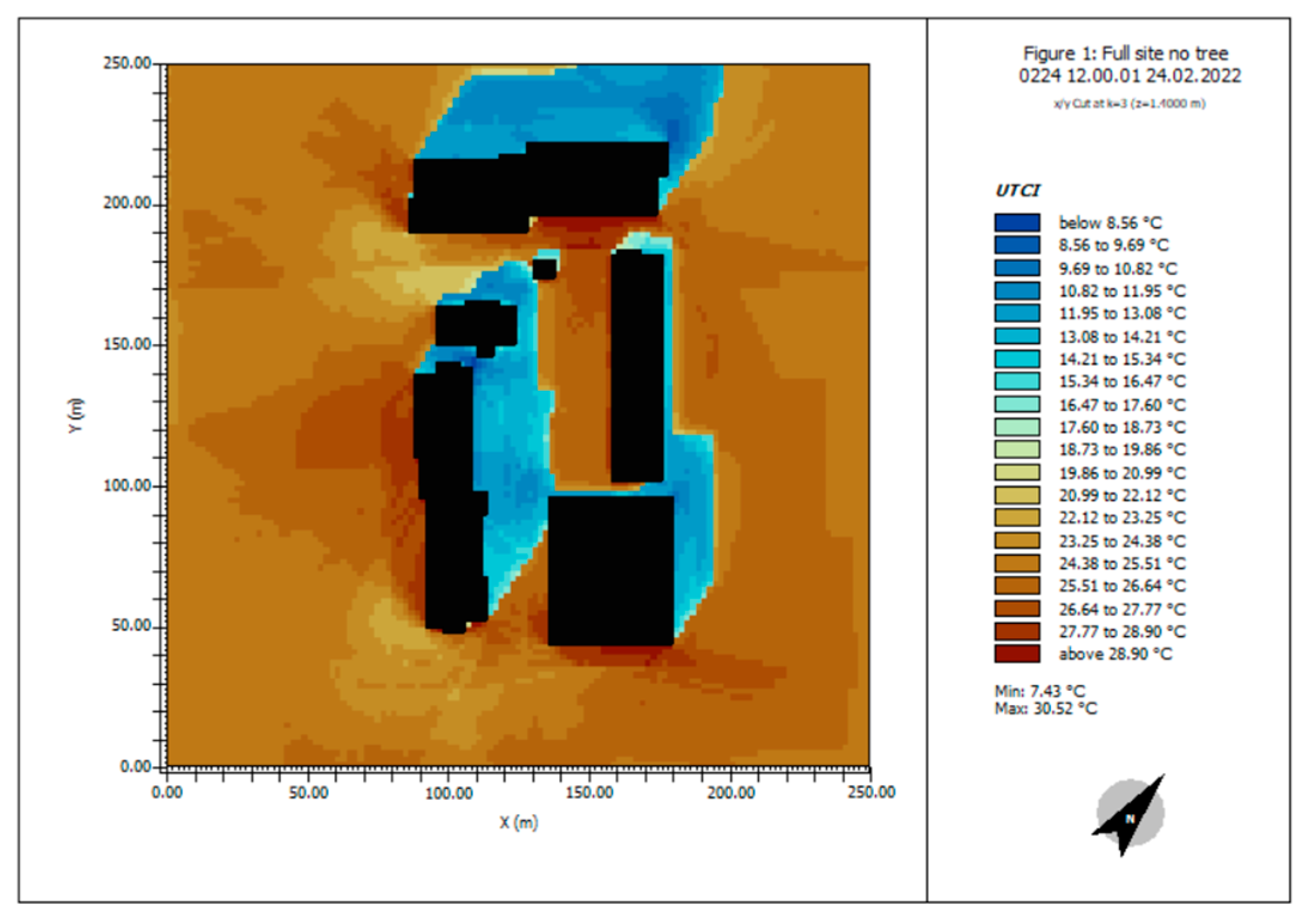

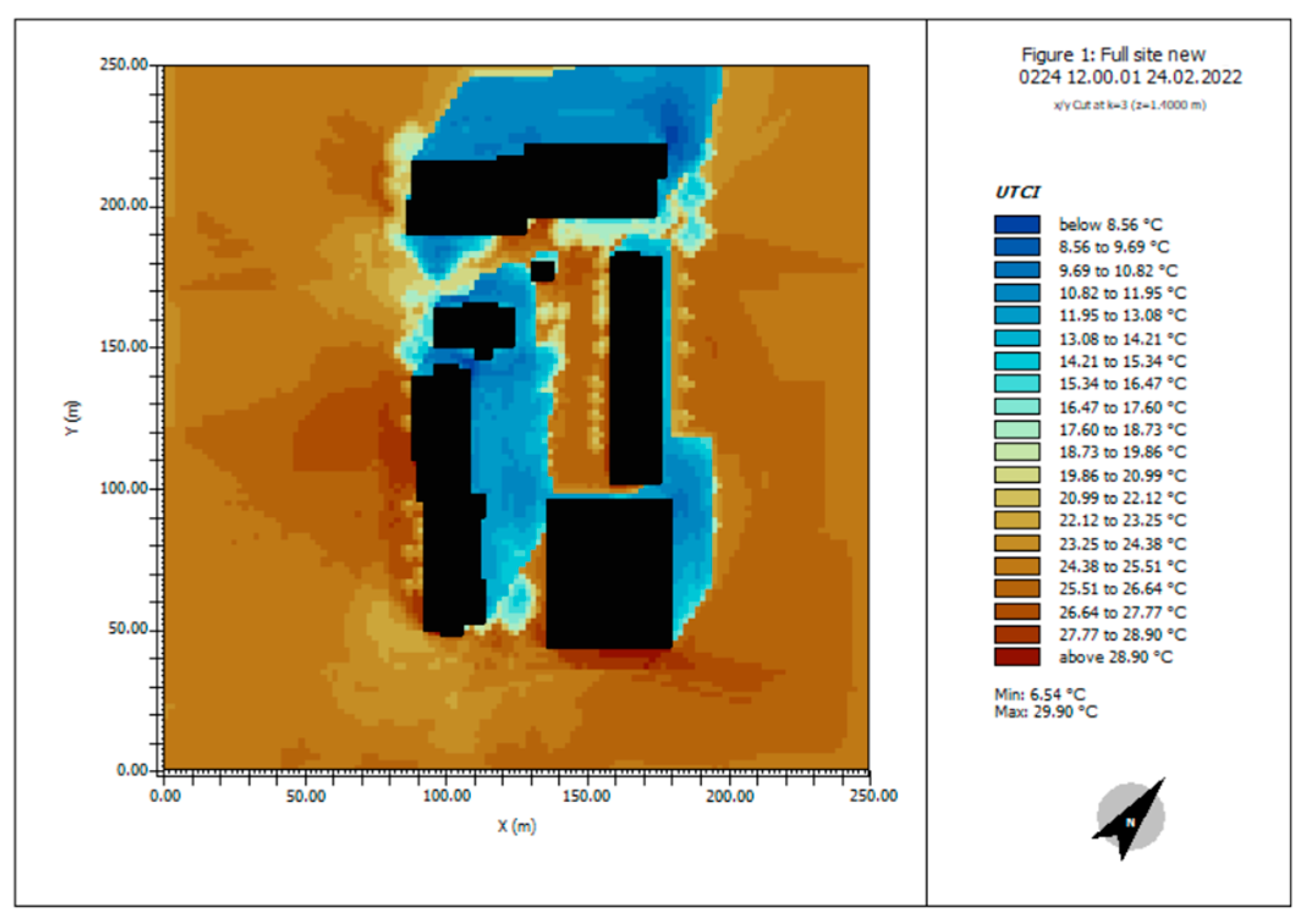

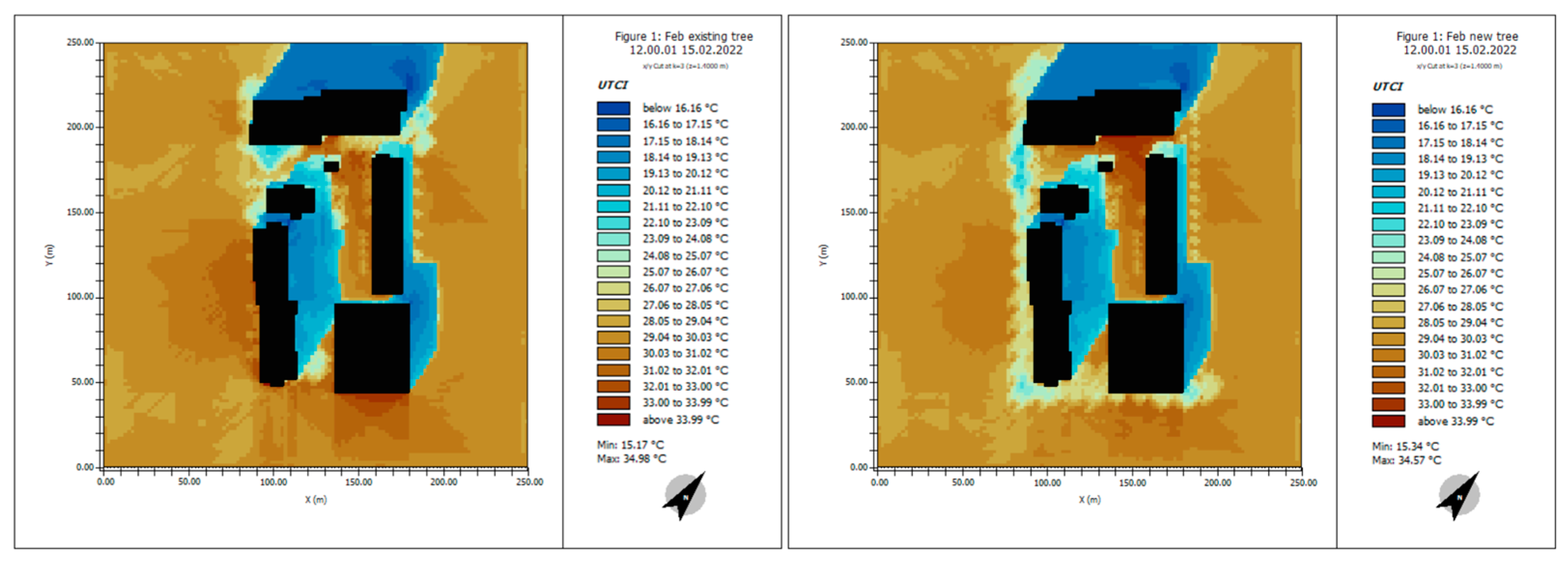



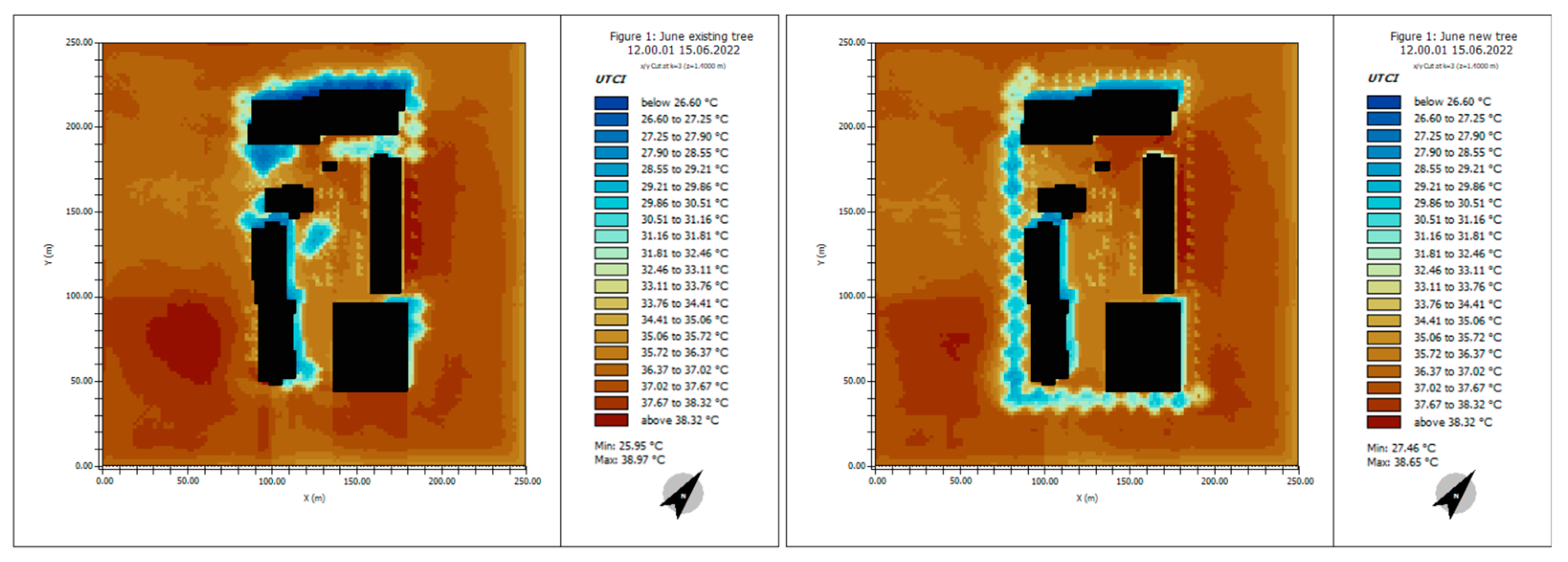
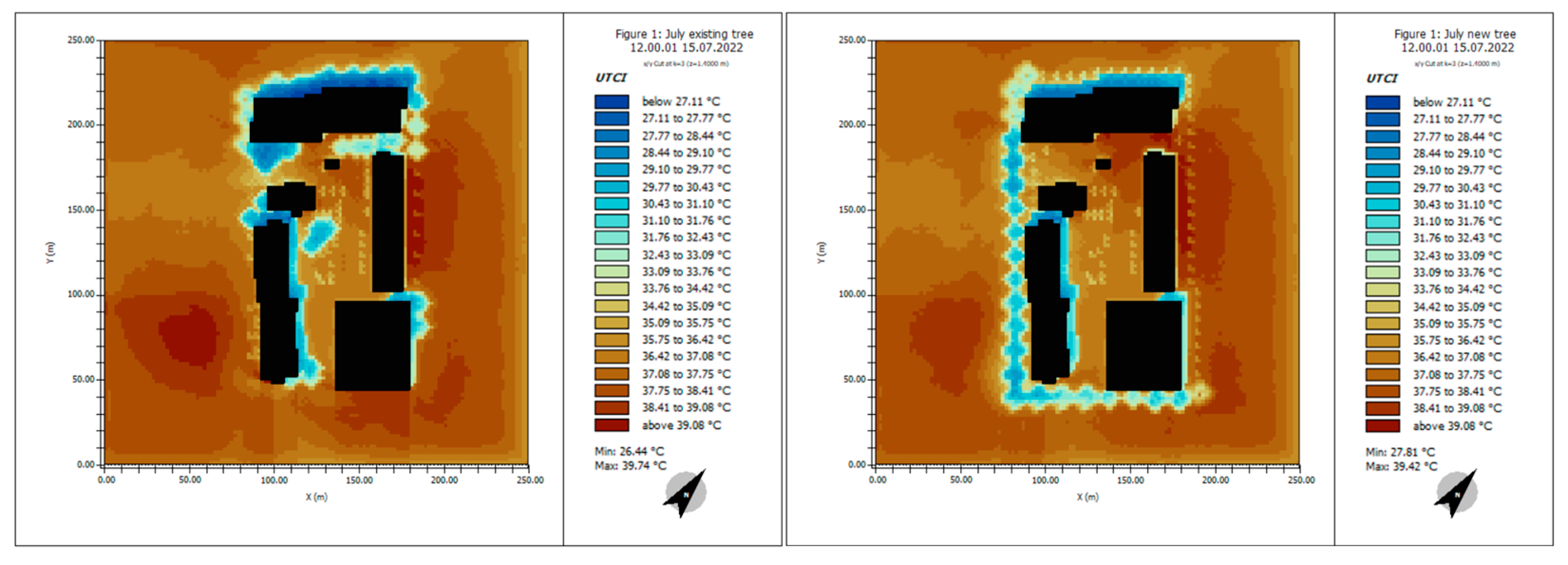
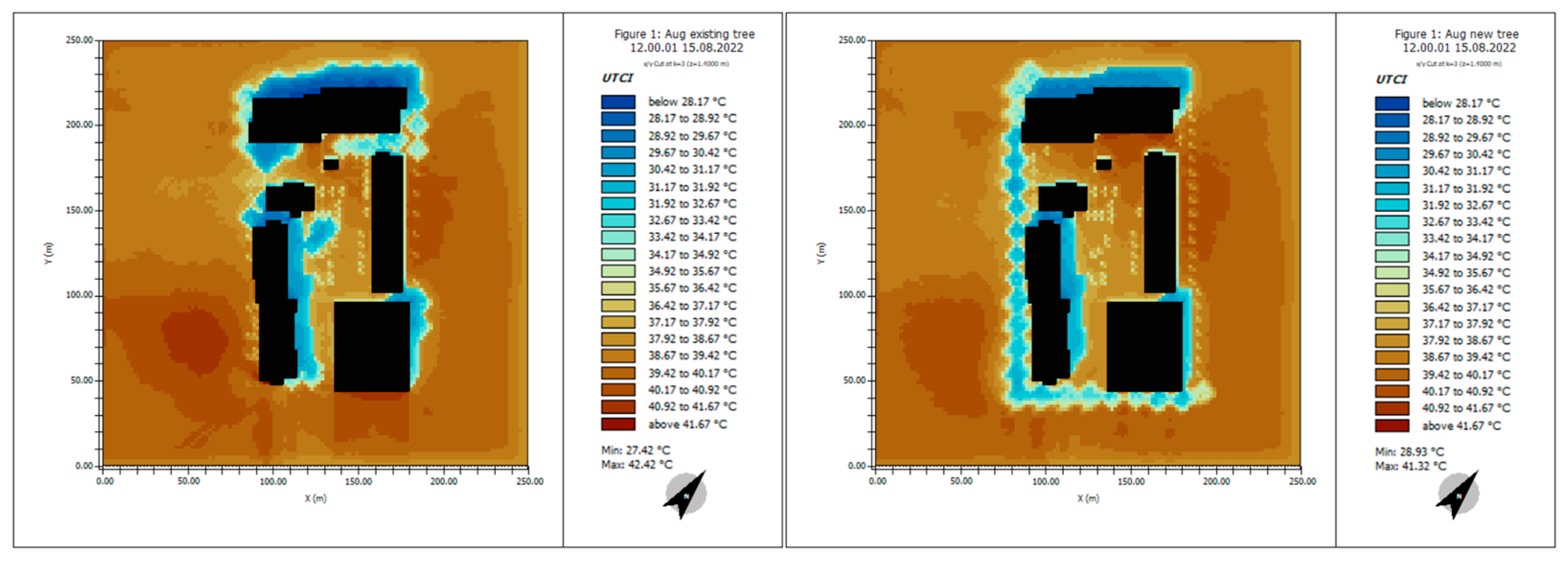

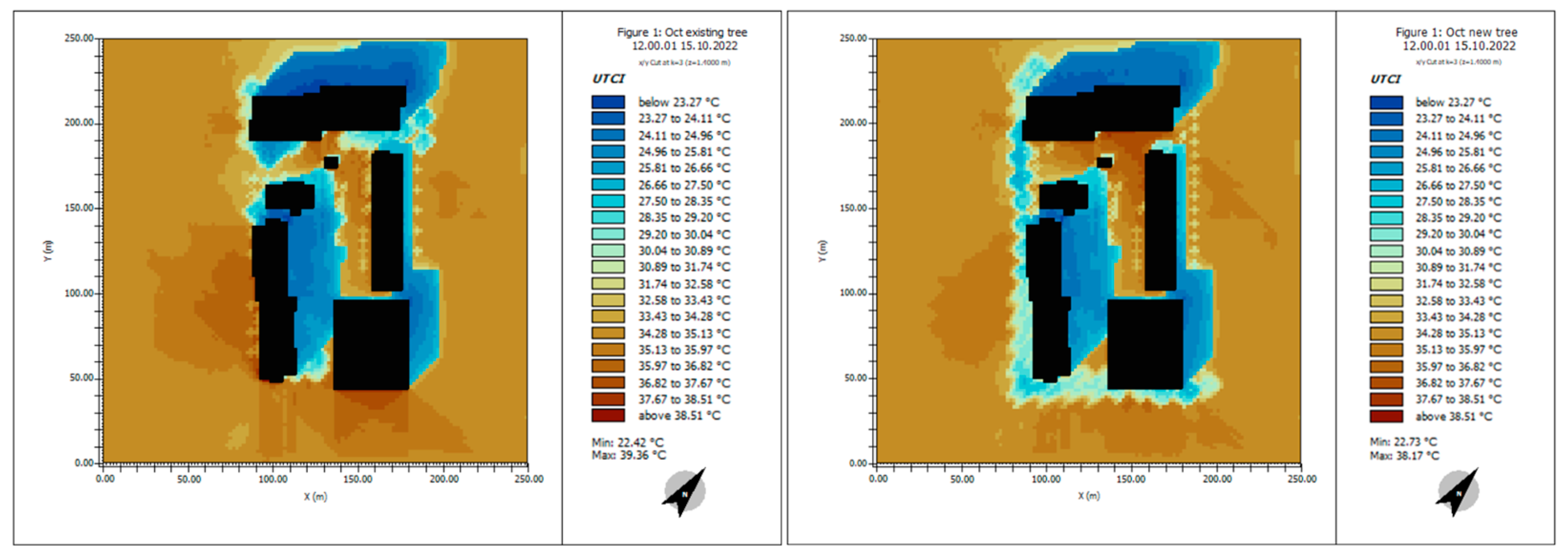

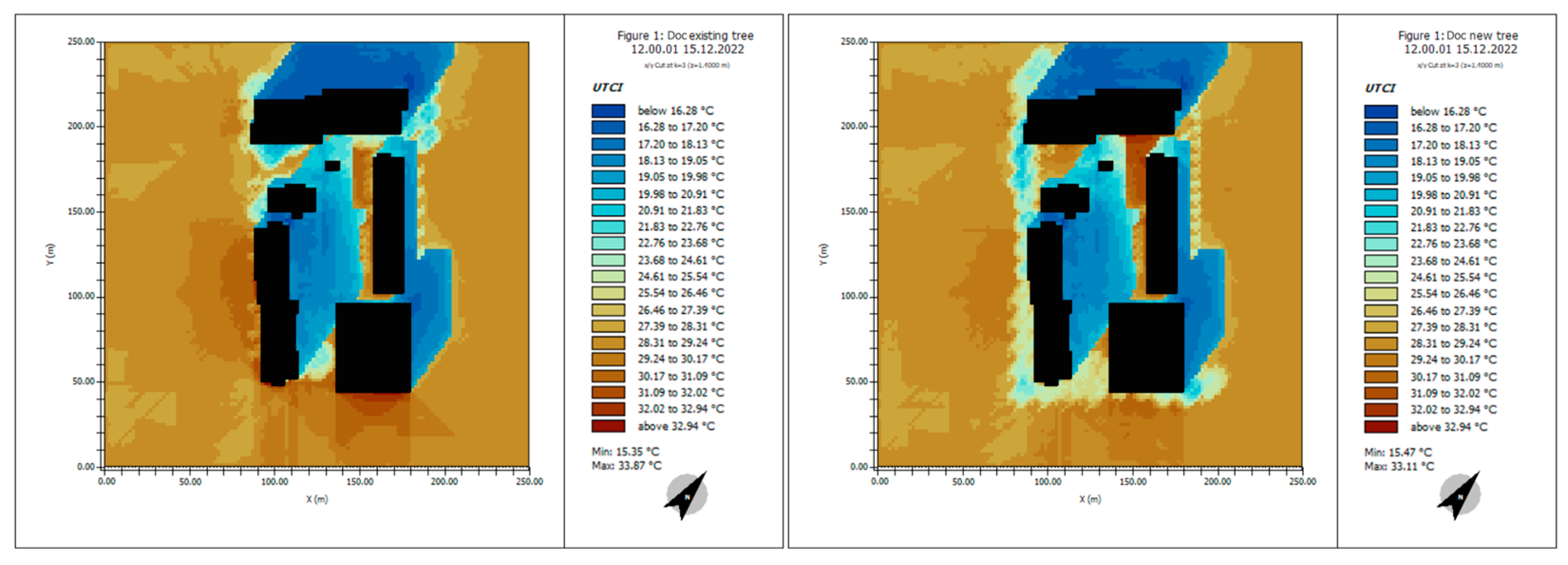
References
- LaDochy, S.; Torres, T.; Hsu, Y.F. Los Angeles’ Urban Heat Island Continues to Grow: Urbanization, Land Use Change Influences. J. Urban Environ. Eng. 2021, 15, 103–116. [Google Scholar] [CrossRef]
- Wikipedia. Climate of Los Angeles. Available online: https://en.wikipedia.org/wiki/Climate_of_Los_Angeles (accessed on 21 January 2024).
- De Azevedo, J.A. Urban Heat and Energy Demand: Application of an Urban Meteorological Network. Ph.D. Thesis, University of Birmingham, Birmingham, UK, 2016. [Google Scholar]
- Chan, E.Y.; Kim, J.H.; Lee, P.; Lin, C. Analysis of Health Risk Perception and Behavior Changes during Elevated Temperatures for an Urban Chinese Population. Prehosp. Disaster Med. 2011, 26, s23–s24. [Google Scholar] [CrossRef]
- Kang, H.; Zhu, B.; de Leeuw, G.; Yu, B.; van der A, R.J.; Lu, W. Impact of Urban Heat Island on Inorganic Aerosol in the Lower Free Troposphere: A Case Study in Hangzhou, China. Atmos. Chem. Phys. 2022, 22, 12345–12367. [Google Scholar] [CrossRef]
- Li, L.; Yu, Q.; Gao, L.; Yu, B.; Lu, Z. The Effect of Urban Land-Use Change on Runoff Water Quality: A Case Study in Hangzhou City. Int. J. Environ. Res. Public Health 2021, 18, 10748. [Google Scholar] [CrossRef]
- Ko, J.; Schlaerth, H.; Bruce, A.; Sanders, K.; Ban-Weiss, G. Measuring the Impacts of a Real-World Neighborhood-Scale Cool Pavement Deployment on Albedo and Temperatures in Los Angeles. Environ. Res. Lett. 2022, 17, 044027. [Google Scholar] [CrossRef]
- Wang, C.; Wang, Z.H.; Yang, J. Cooling Effect of Urban Trees on the Built Environment of Contiguous United States. Earth’s Future 2018, 6, 1066–1081. [Google Scholar] [CrossRef]
- Ngao, J.; Cárdenas, M.L.; Améglio, T.; Colin, J.; Saudreau, M. Implications of Urban Land Management on the Cooling Properties of Urban Trees: Citizen Science and Laboratory Analysis. Sustainability 2021, 13, 13656. [Google Scholar] [CrossRef]
- Yun, S.H.; Park, C.Y.; Kim, E.S.; Lee, D.K. A Multi-Layer Model for Transpiration of Urban Trees Considering Vertical Structure. Forests 2020, 11, 1164. [Google Scholar] [CrossRef]
- Zhang, R.; Zhao, Z. Giant Trees Exhibited Great Cooling Effect in Residential Area Southwest of China. Forests 2022, 13, 1516. [Google Scholar] [CrossRef]
- Vo, T.T.; Hu, L. Diurnal Evolution of Urban Tree Temperature at a City Scale. Sci. Rep. 2021, 11, 10491. [Google Scholar] [CrossRef]
- Yan, S.; Zhang, T.; Wu, Y.; Lv, C.; Qi, F.; Chen, Y.; Wu, X.; Shen, Y. Cooling Effect of Trees with Different Attributes and Layouts on the Surface Heat Island of Urban Street Canyons in Summer. Atmosphere 2023, 14, 857. [Google Scholar] [CrossRef]
- Heat Island Effect. Available online: https://www.epa.gov/heatislands/ (accessed on 21 January 2024).
- Zhao, Q.; Wentz, E.A.; Murray, A.T. Tree Shade Coverage Optimization in an Urban Residential Environment. Build. Environ. 2017, 115, 269–280. [Google Scholar] [CrossRef]
- Winbourne, J.B.; Jones, T.S.; Garvey, S.M.; Harrison, J.L.; Wang, L.; Li, D.; Hutyra, L.R. Tree Transpiration and Urban Temperatures: Current Understanding, Implications, and Future Research Directions. BioScience 2020, 70, 576–588. [Google Scholar] [CrossRef]
- Wu, Z.; Chen, L.-D. Optimizing the Spatial Arrangement of Trees in Residential Neighborhoods for Better Cooling Effects: Integrating Modeling with In-Situ Measurements. Landsc. Urban Plan. 2017, 167, 463–472. [Google Scholar] [CrossRef]
- He, C.; Zhou, L.; Yao, Y.; Ma, W.; Kinney, P.L. Cooling Effect of Urban Trees and Its Spatiotemporal Characteristics: A Comparative Study. Build. Environ. 2021, 204, 108103. [Google Scholar] [CrossRef]
- Coutts, A.M.; White, E.C.; Tapper, N.J.; Beringer, J.; Livesley, S.J. Temperature and Human Thermal Comfort Effects of Street Trees across Three Contrasting Street Canyon Environments. Theor. Appl. Climatol. 2016, 124, 55–68. [Google Scholar] [CrossRef]
- Thermal Comfort Indices. Available online: https://climate-adapt.eea.europa.eu/en/metadata/indicators/thermal-comfort-indices-universal-thermal-climate-index-1979-2019 (accessed on 21 January 2024).
- Błażejczyk, K.; Matzarakis, A.; Baranowski, J. Geoecological Evaluation of Local Surroundings for the Purposes of Recreational Tourism. Misc. Geogr. 2014, 18, 5–12. [Google Scholar]
- Ouyang, W.; Sinsel, T.; Simon, H.; Morakinyo, T.E.; Liu, H.; Ng, E. Evaluating the thermal-radiative performance of ENVI-met model for green infrastructure typologies: Experience from a subtropical climate. Buildings 2022, 207, 108427. [Google Scholar] [CrossRef]
- Ayyad, Y.; Sharples, S. Envi-MET Validation and Sensitivity Analysis Using Field Measurements in a Hot Arid Climate. IOP Conf. Ser. Earth Environ. Sci. 2019, 329, 012040. [Google Scholar] [CrossRef]
- Donovan, G.H.; Butry, D.T. The Value of Shade: Estimating the Effect of Urban Trees on Summertime Electricity Use. Energy Build. 2009, 41, 662–668. [Google Scholar] [CrossRef]
- Yin, Y.; Li, S.; Xing, X.; Zhou, X.; Kang, Y.; Hu, Q.; Li, Y. Cooling Benefits of Urban Tree Canopy: A Systematic Review. Sustainability 2024, 16, 4955. [Google Scholar] [CrossRef]
- Gill, S.E.; Handley, J.F.; Ennos, A.R.; Pauleit, S. Adapting Cities for Climate Change: The Role of the Green Infrastructure. Built Environ. 2007, 33, 115–133. [Google Scholar] [CrossRef]
- Morakinyo, T.E.; Kong, L.; Lau, K.K.-L.; Yuan, C.; Ng, E. Urban Tree Design Approaches for Mitigating Daytime Urban Heat Island Effects in a High-Density Urban Environment. Energy Build. 2017, 114, 379–386. [Google Scholar]
- Rahman, M.A.; Moser, A.; Gold, A.; Rötzer, T.; Pauleit, S. Vertical Air Temperature Gradients under the Shade of Two Contrasting Urban Tree Species during Different Types of Summer Days. Sci. Total Environ. 2017, 633, 100–111. [Google Scholar] [CrossRef] [PubMed]
- Morakinyo, T.E.; Lam, Y.F.; Ng, E. Right Tree, Right Place (Urban Canyon): Tree Species Selection Approach for Optimum Urban Heat Mitigation—Development and Evaluation. Urban For. Urban Green. 2018, 34, 251–262. [Google Scholar] [CrossRef]
- Morakinyo, T.E.; Kong, L.; Lau, K.K.-L.; Yuan, C.; Ng, E. A Study on the Impact of Shadow-Cast and Tree Species on In-Canyon and Neighborhood’s Thermal Comfort. Build. Environ. 2016, 115, 1–17. [Google Scholar] [CrossRef]
- Zhang, Y.; Murray, A.T.; Turner, B.L. Optimizing Green Space Locations to Reduce Daytime and Nighttime Urban Heat Island Effects in Phoenix, Arizona. Landsc. Urban Plan. 2017, 165, 162–171. [Google Scholar] [CrossRef]
- Ng, E.; Chen, L.; Wang, Y.; Yuan, C. A Study on the Cooling Effects of Greening in a High-Density City: An Experience from Hong Kong. Build. Environ. 2012, 47, 256–271. [Google Scholar] [CrossRef]
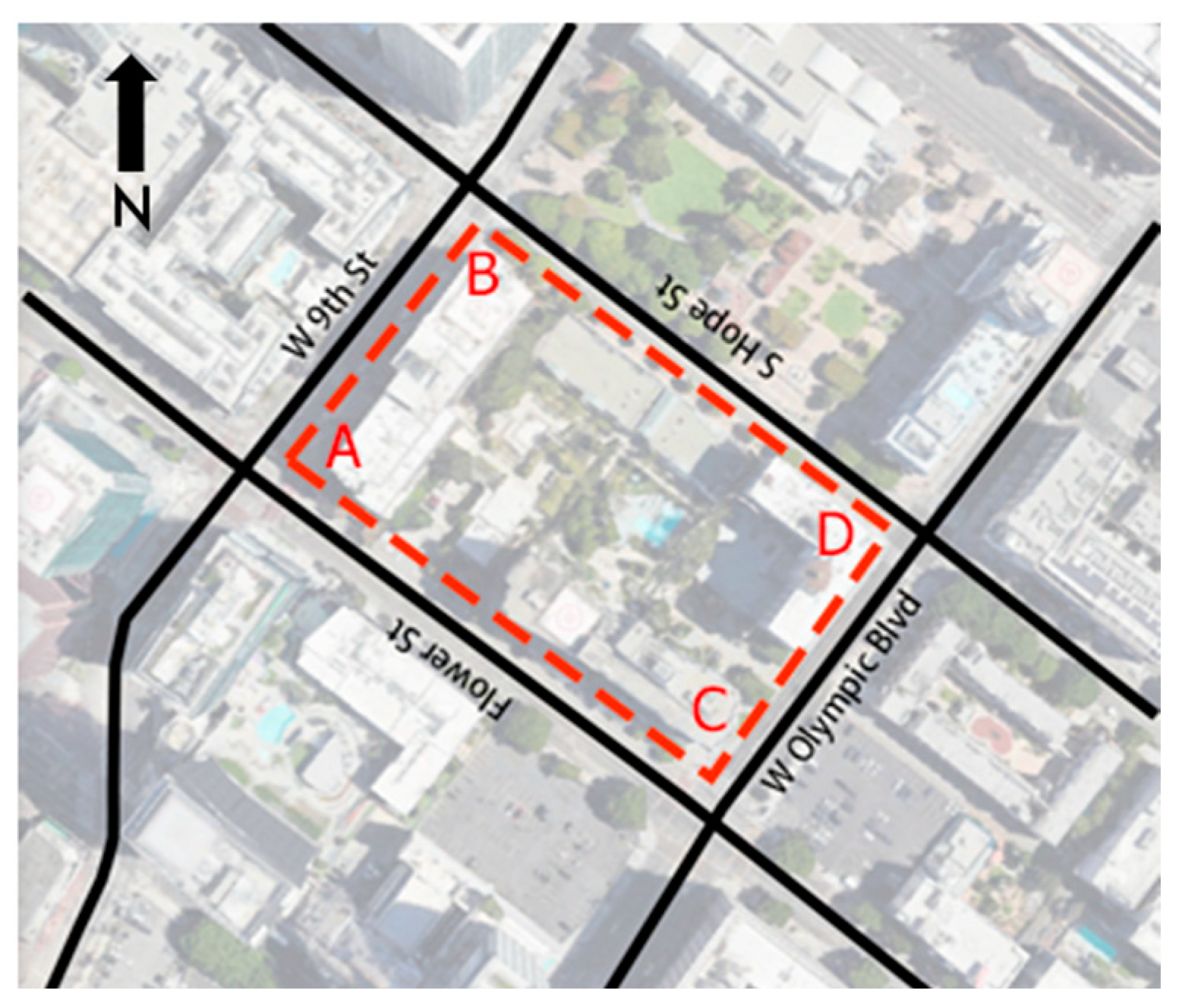
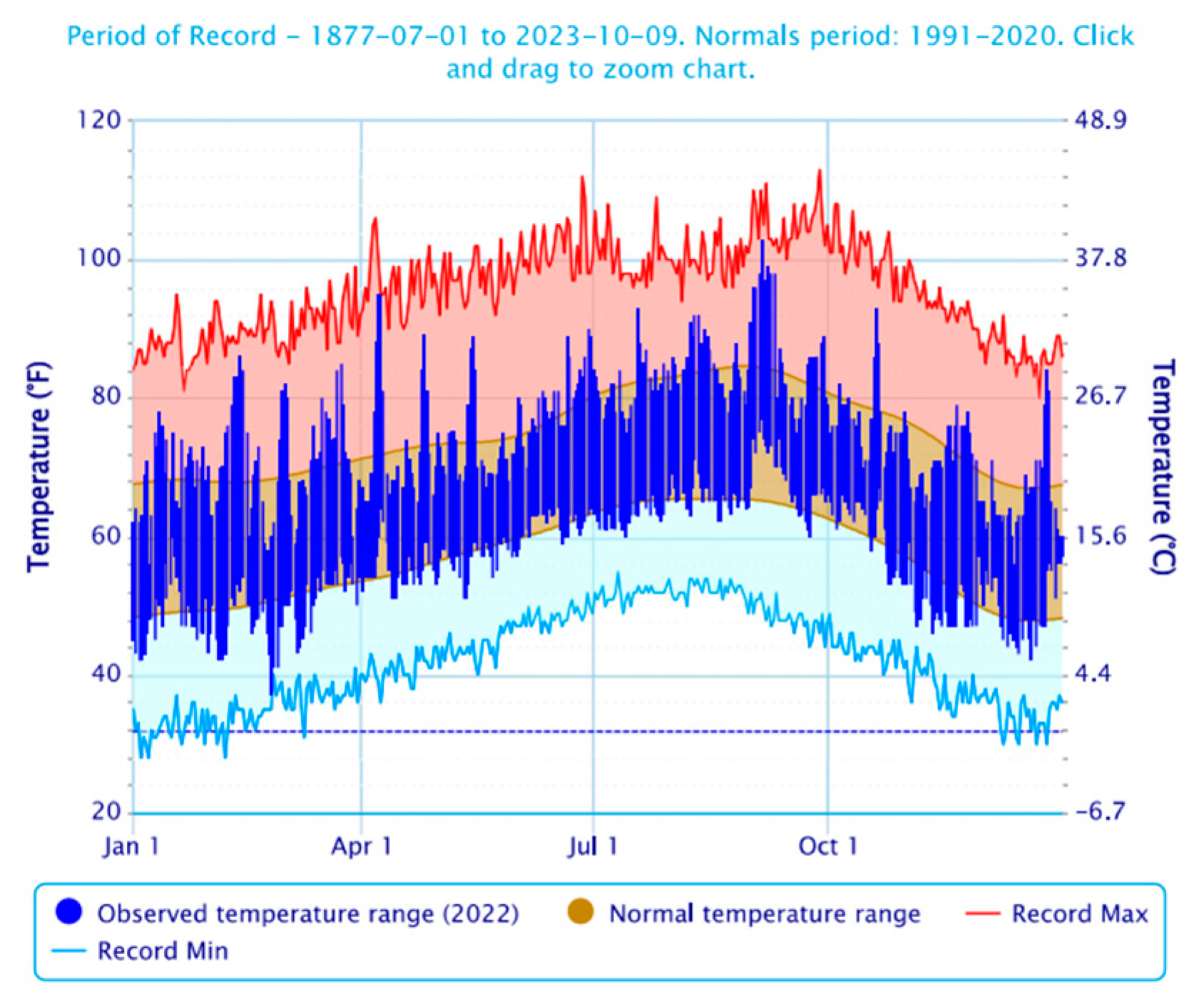


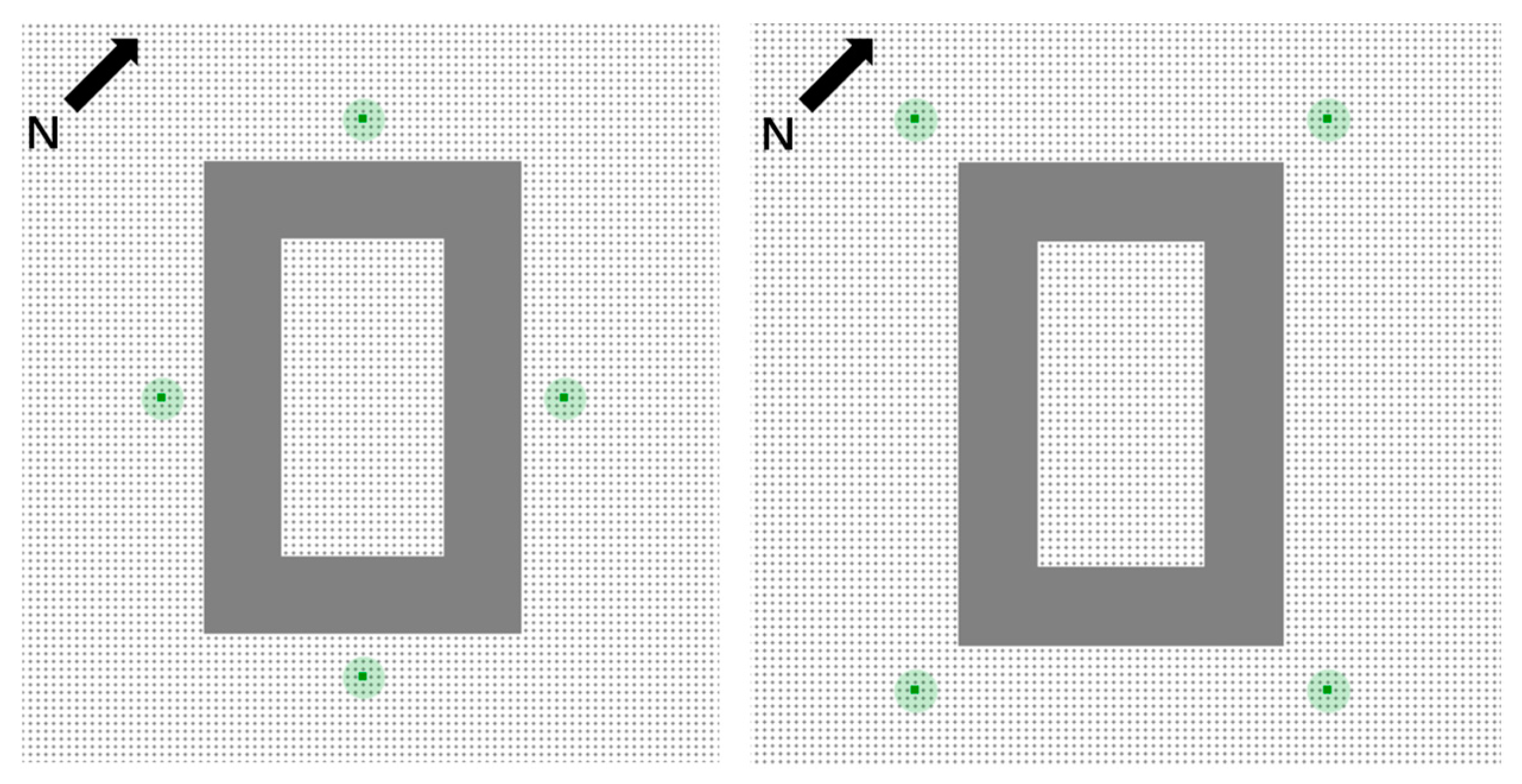
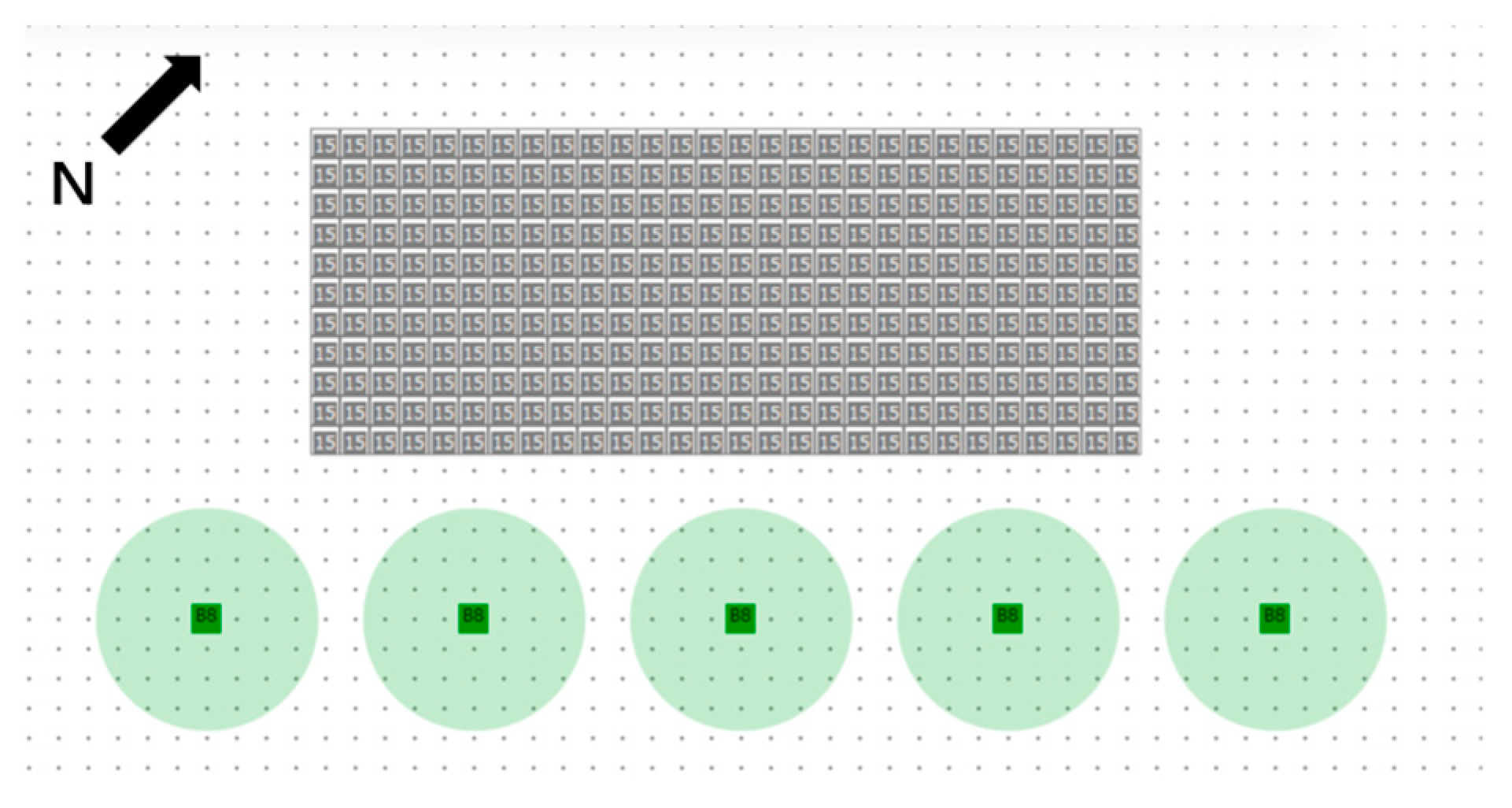
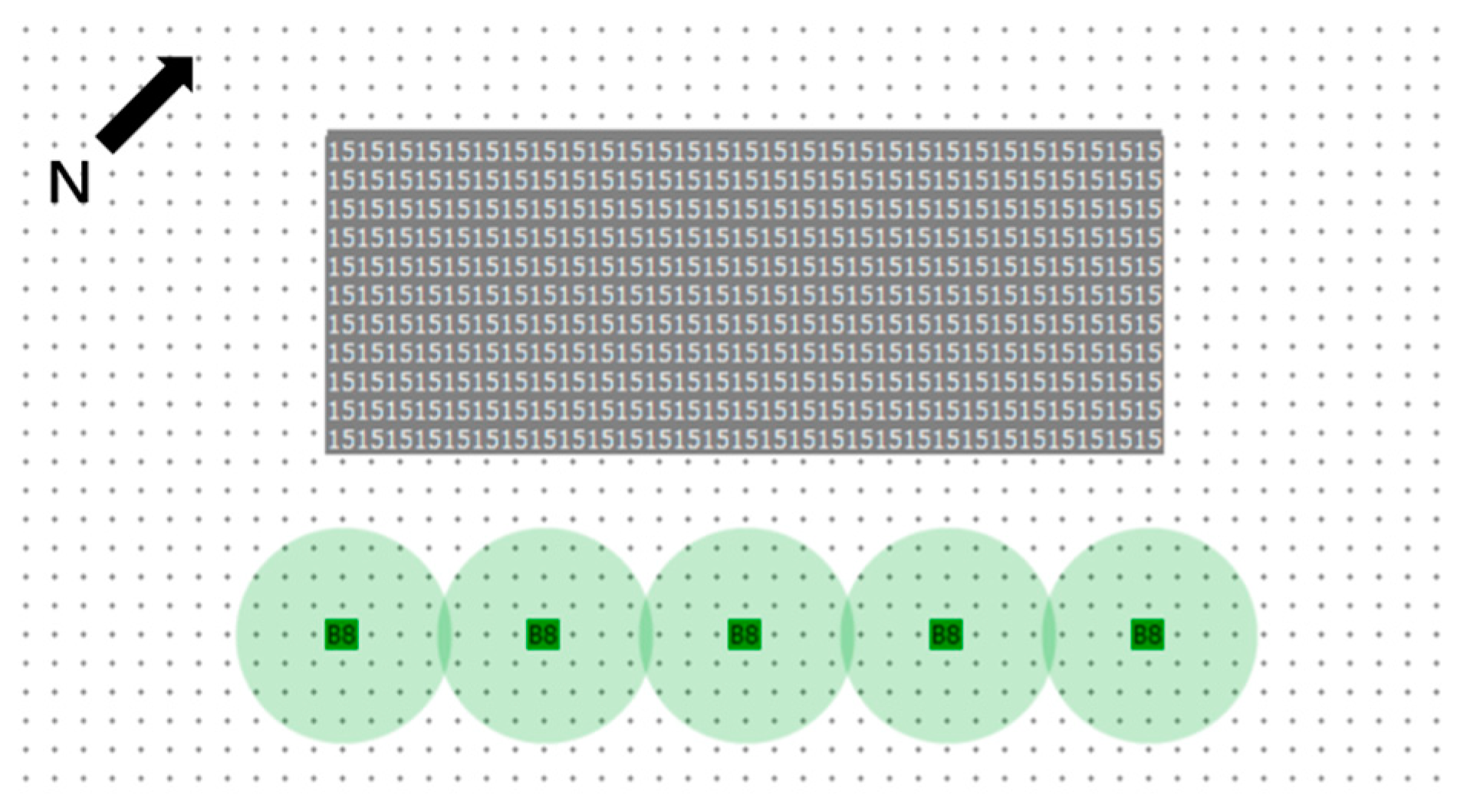
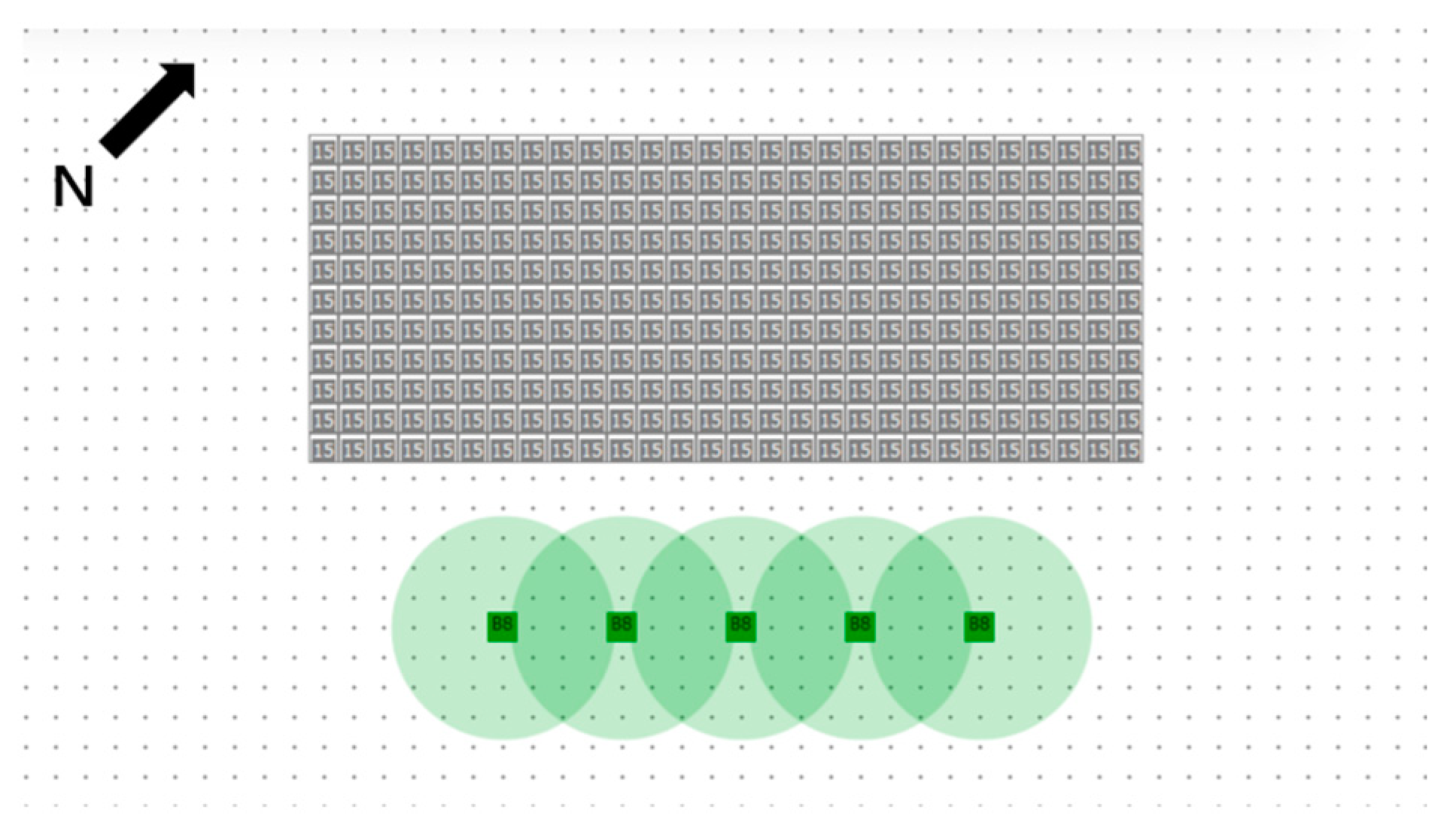

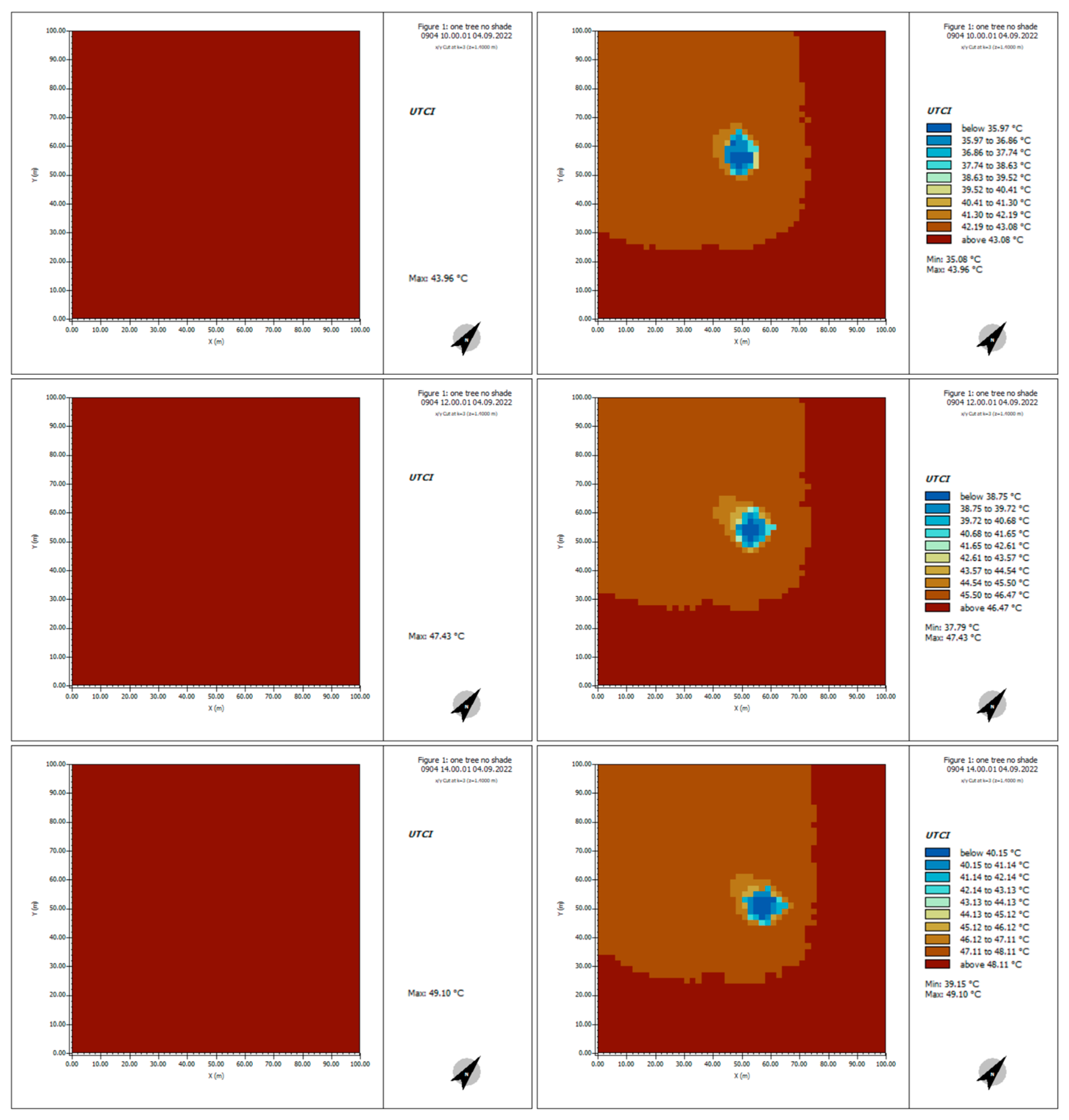
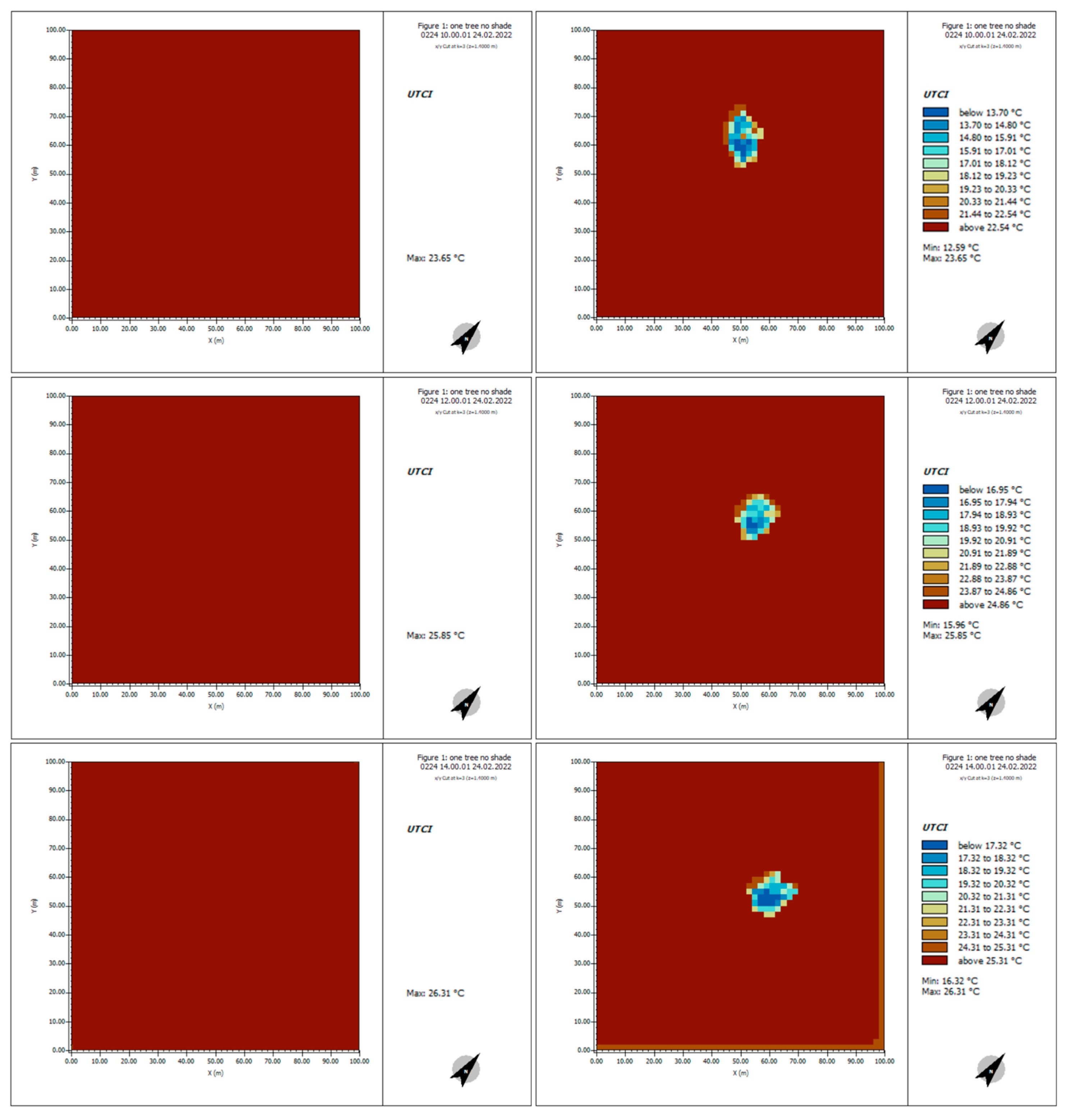

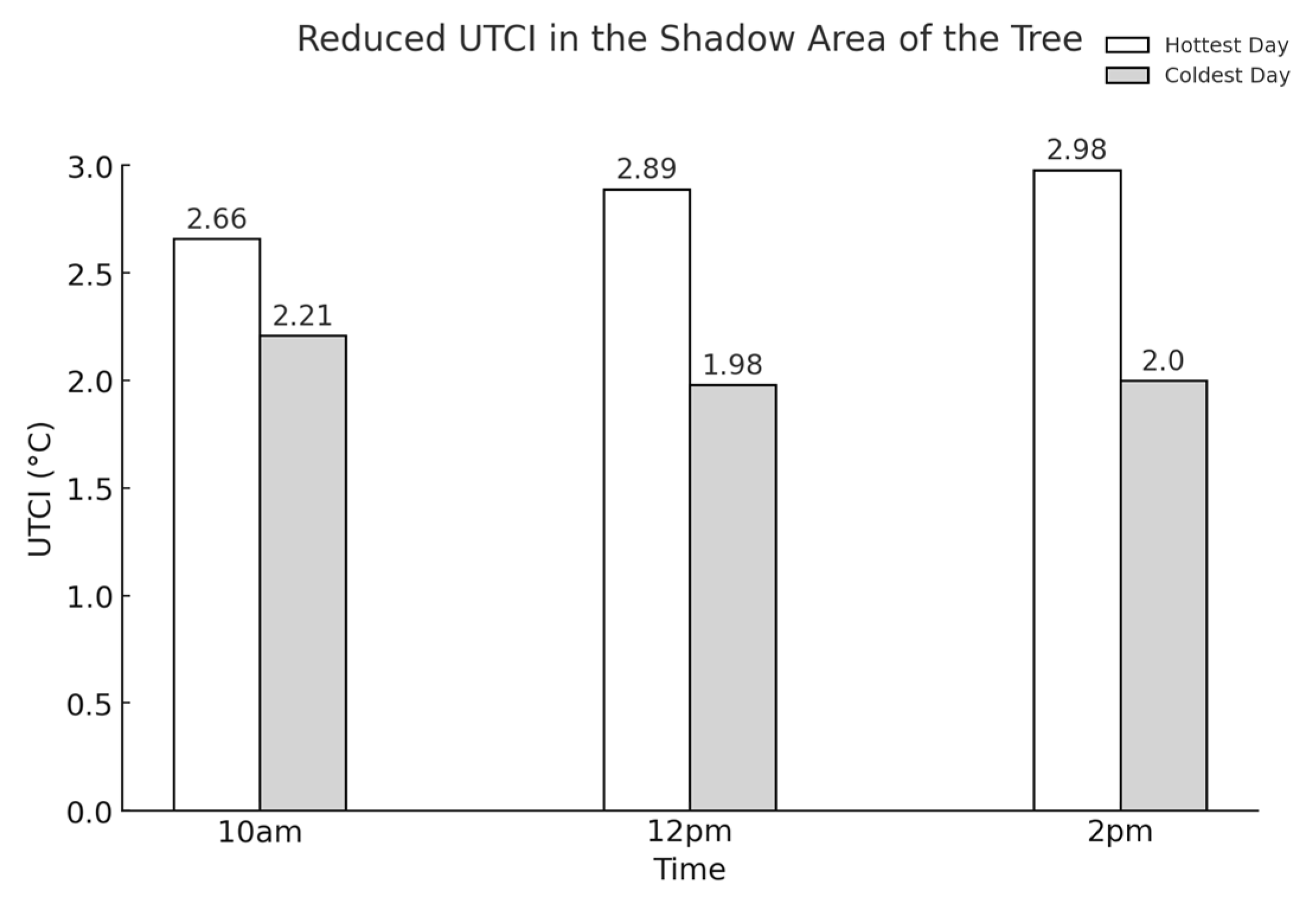


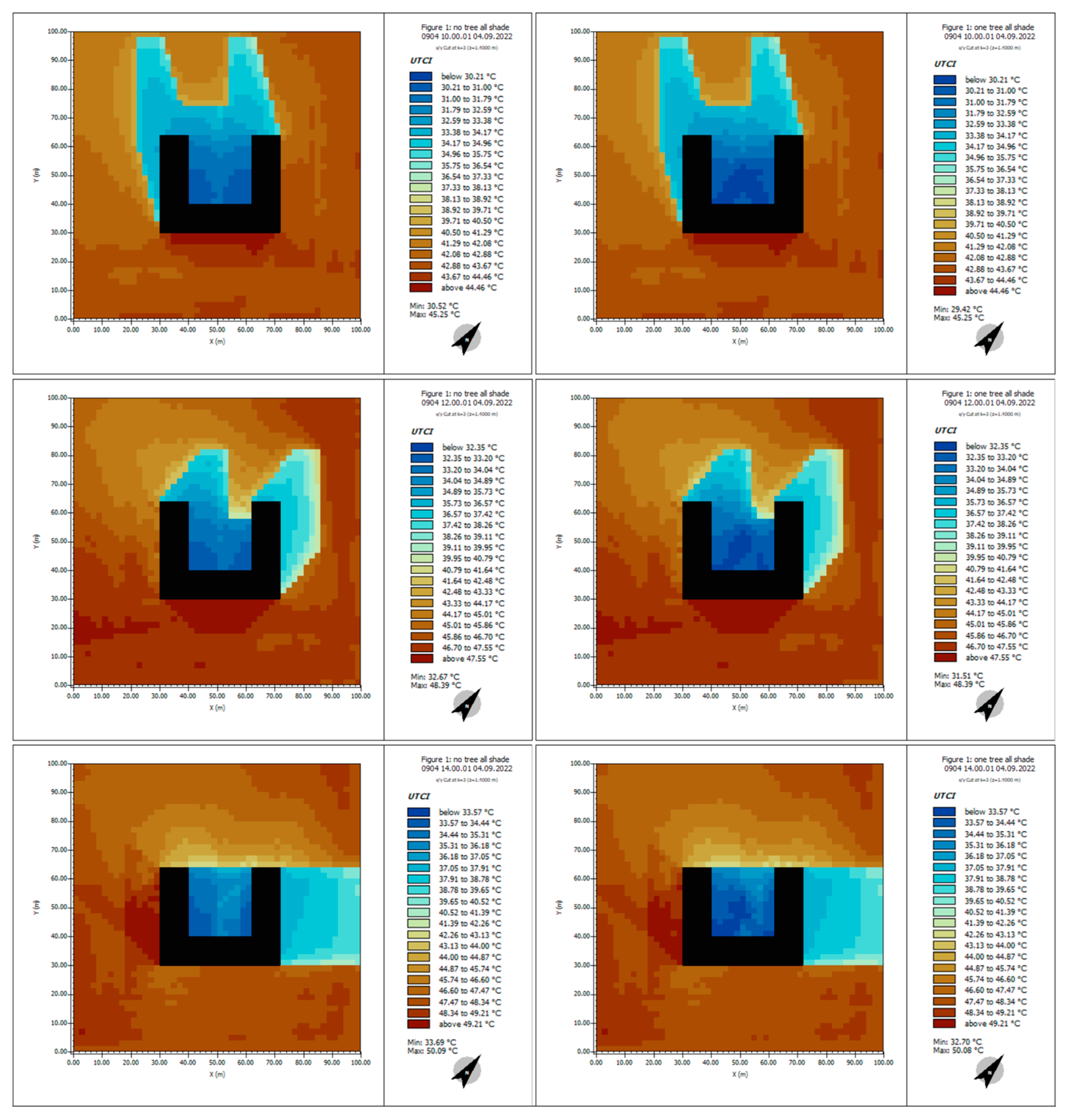
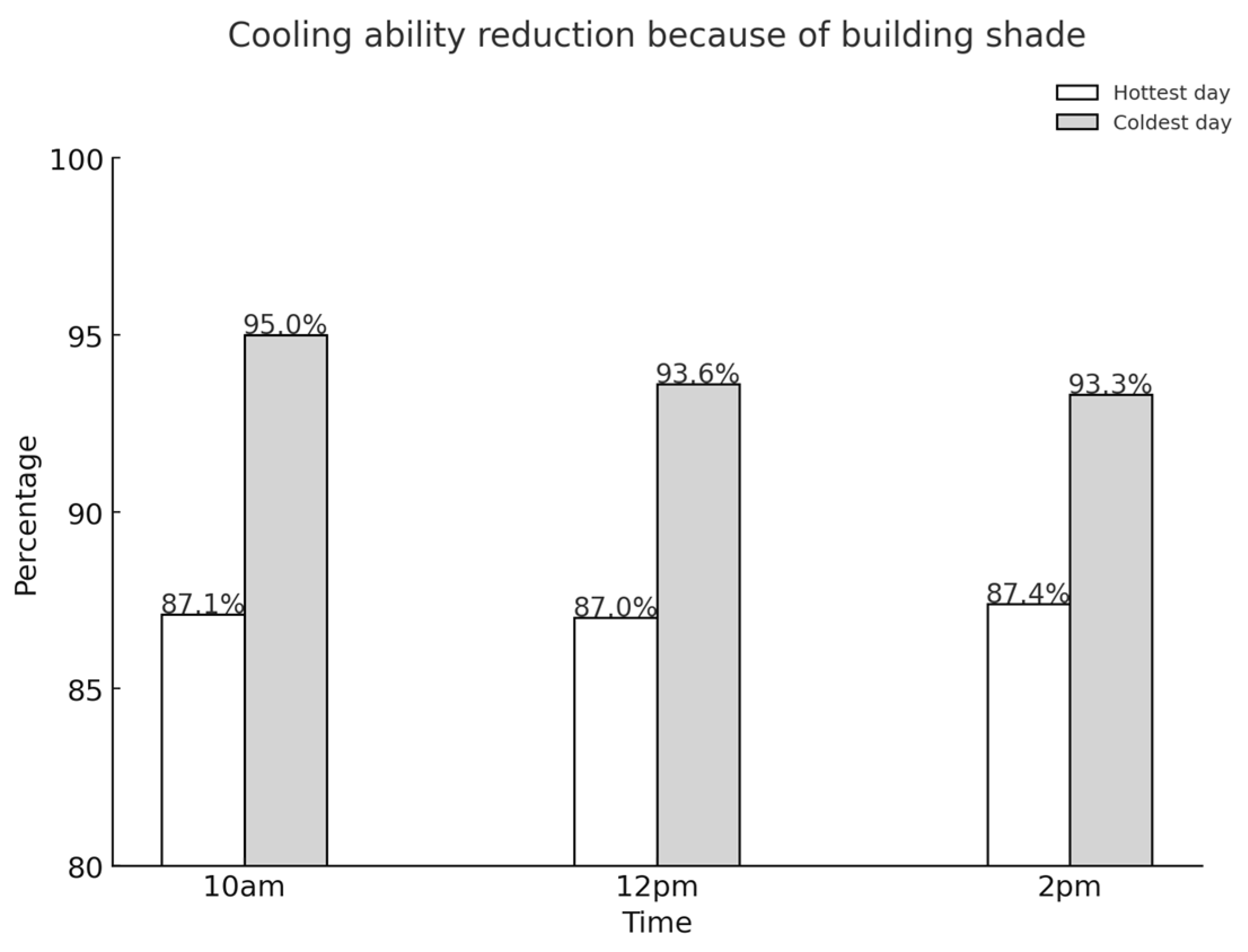

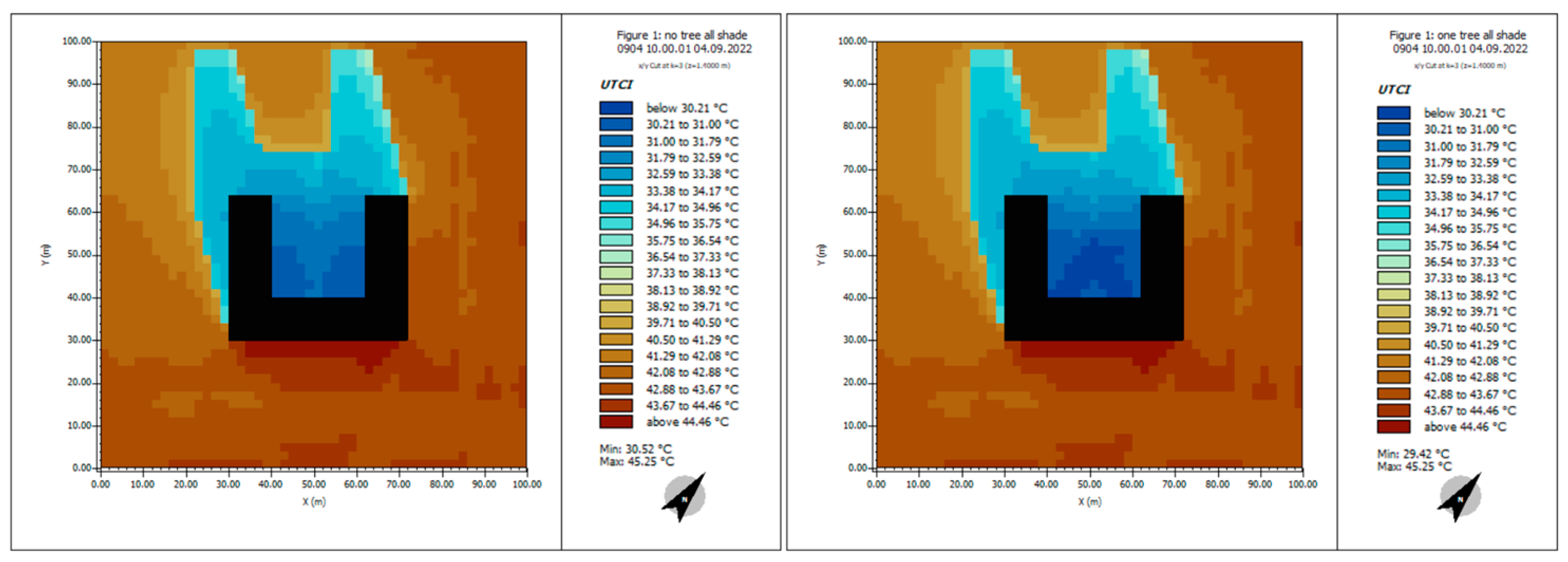


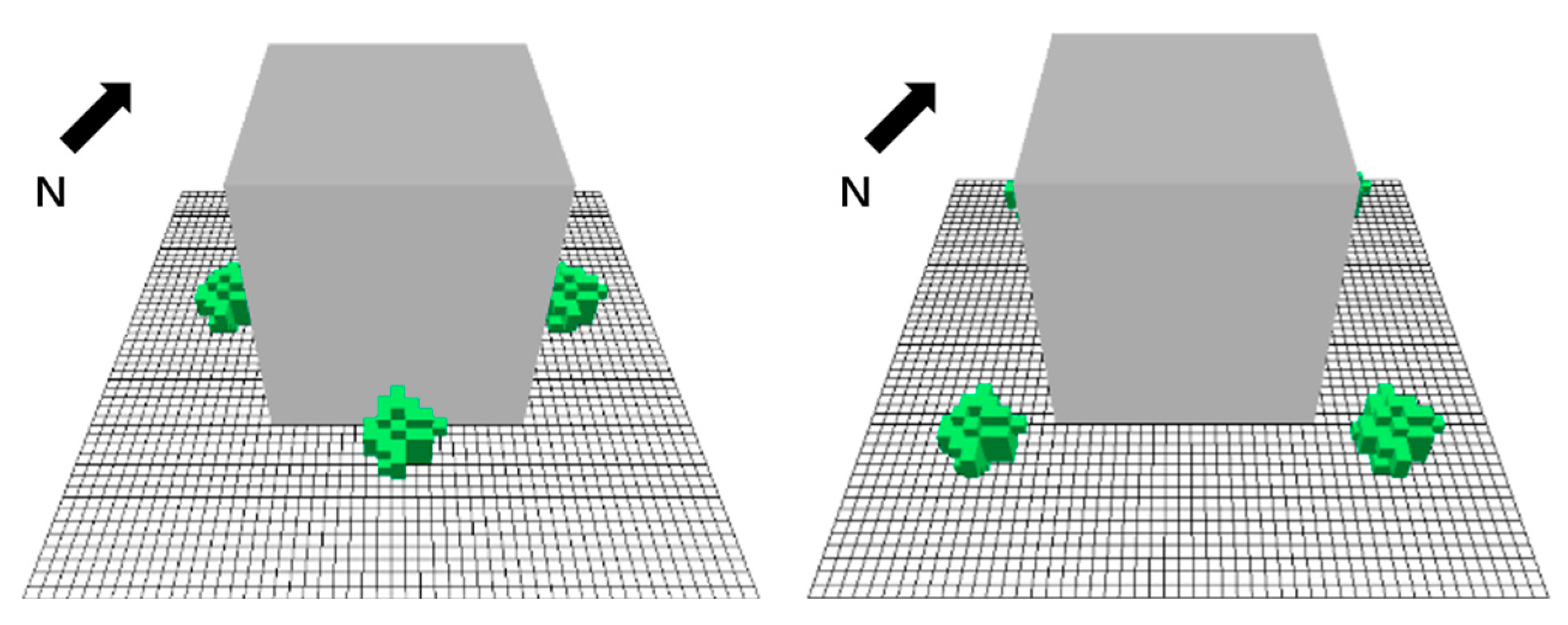

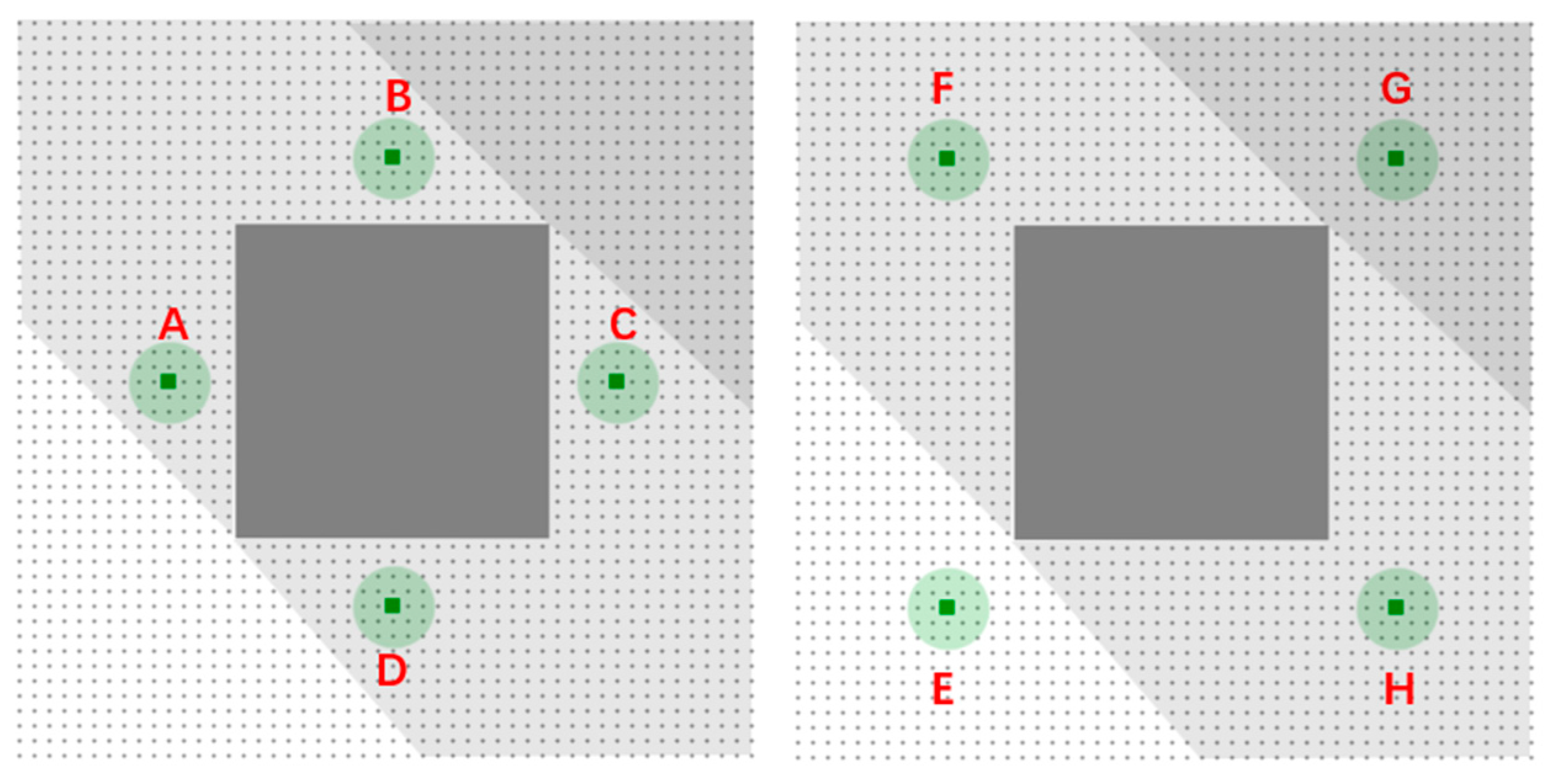

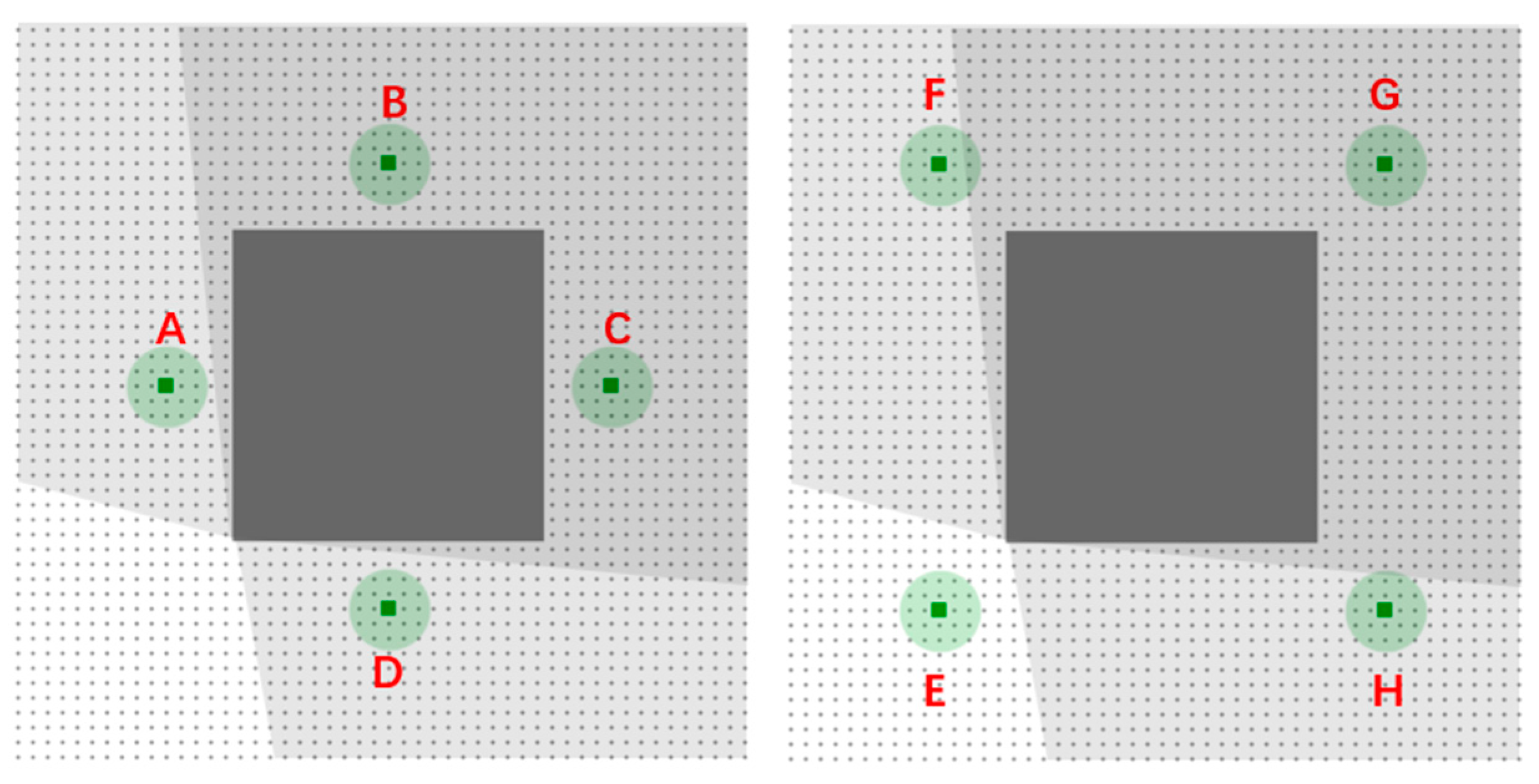

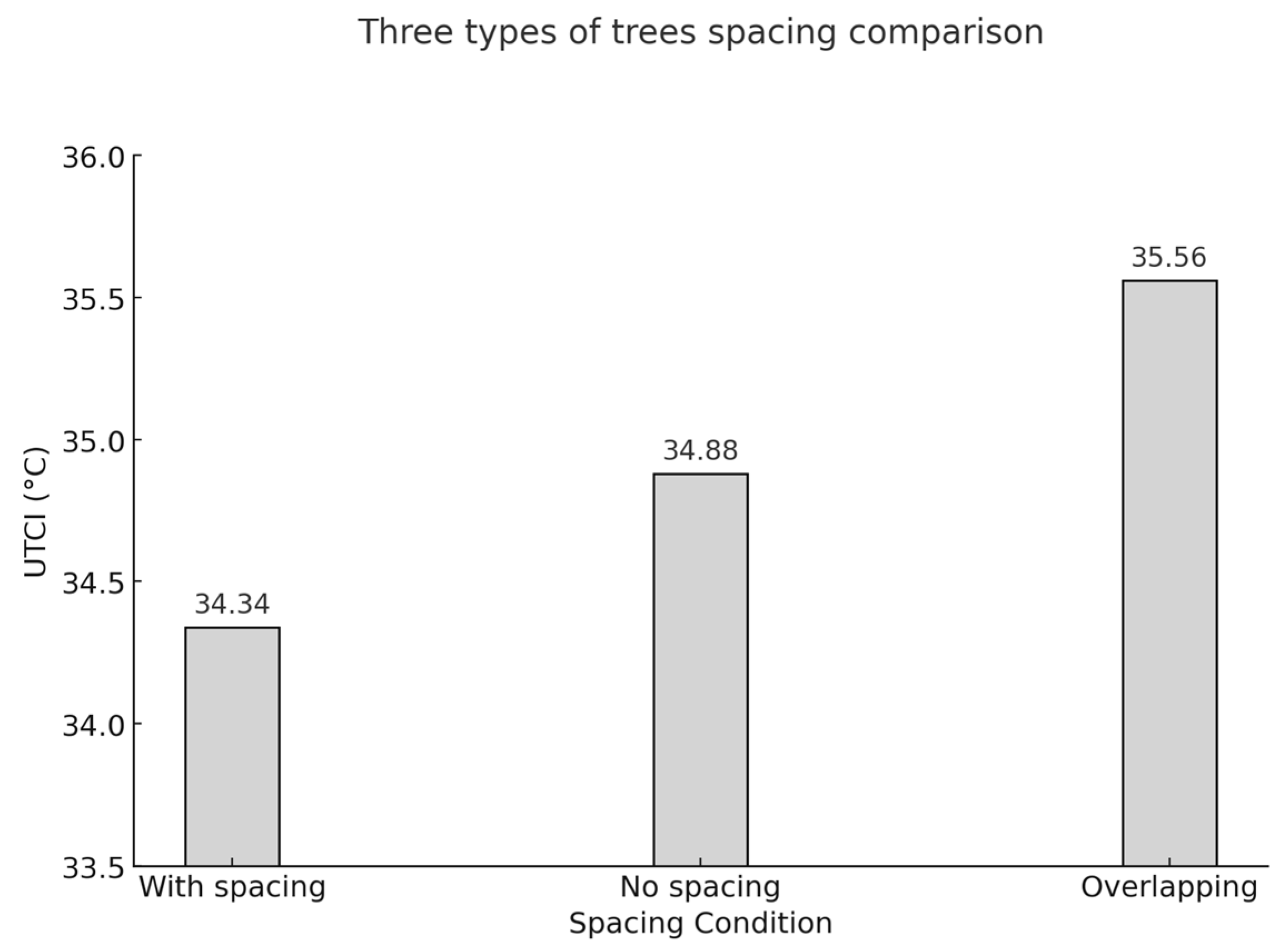

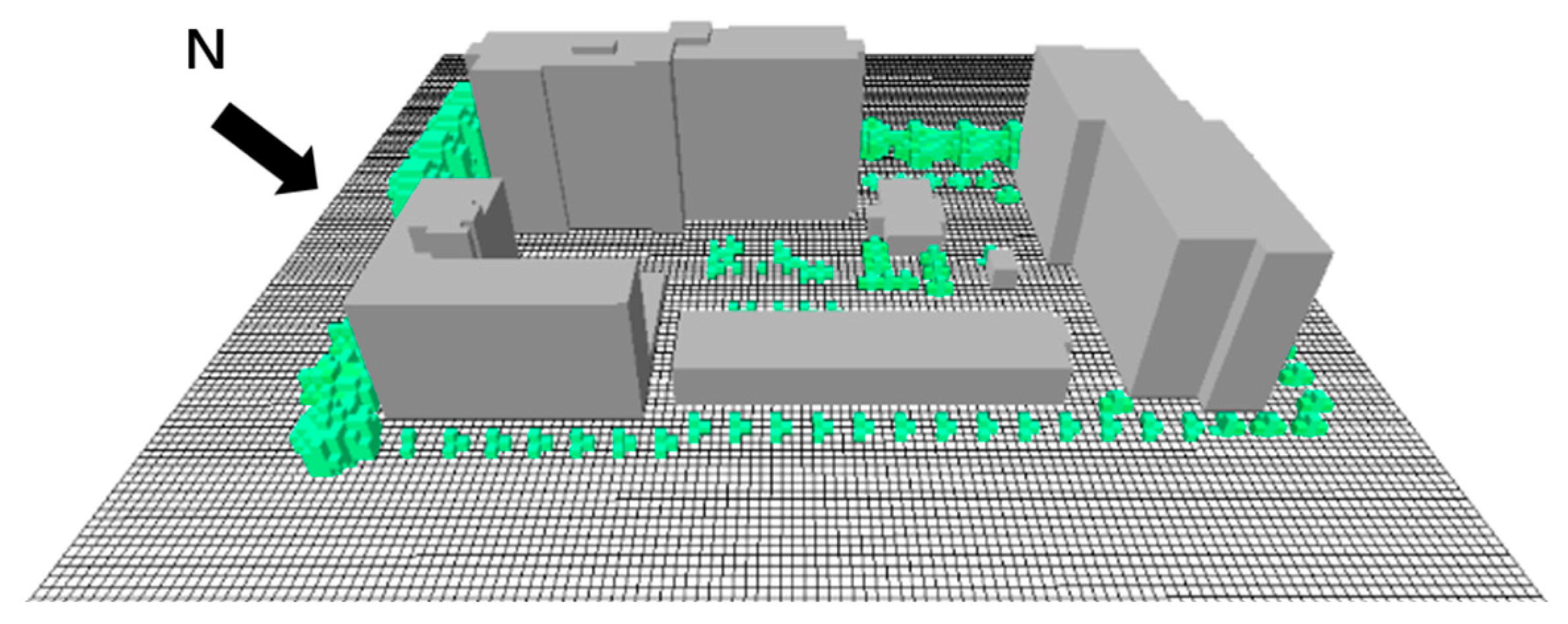
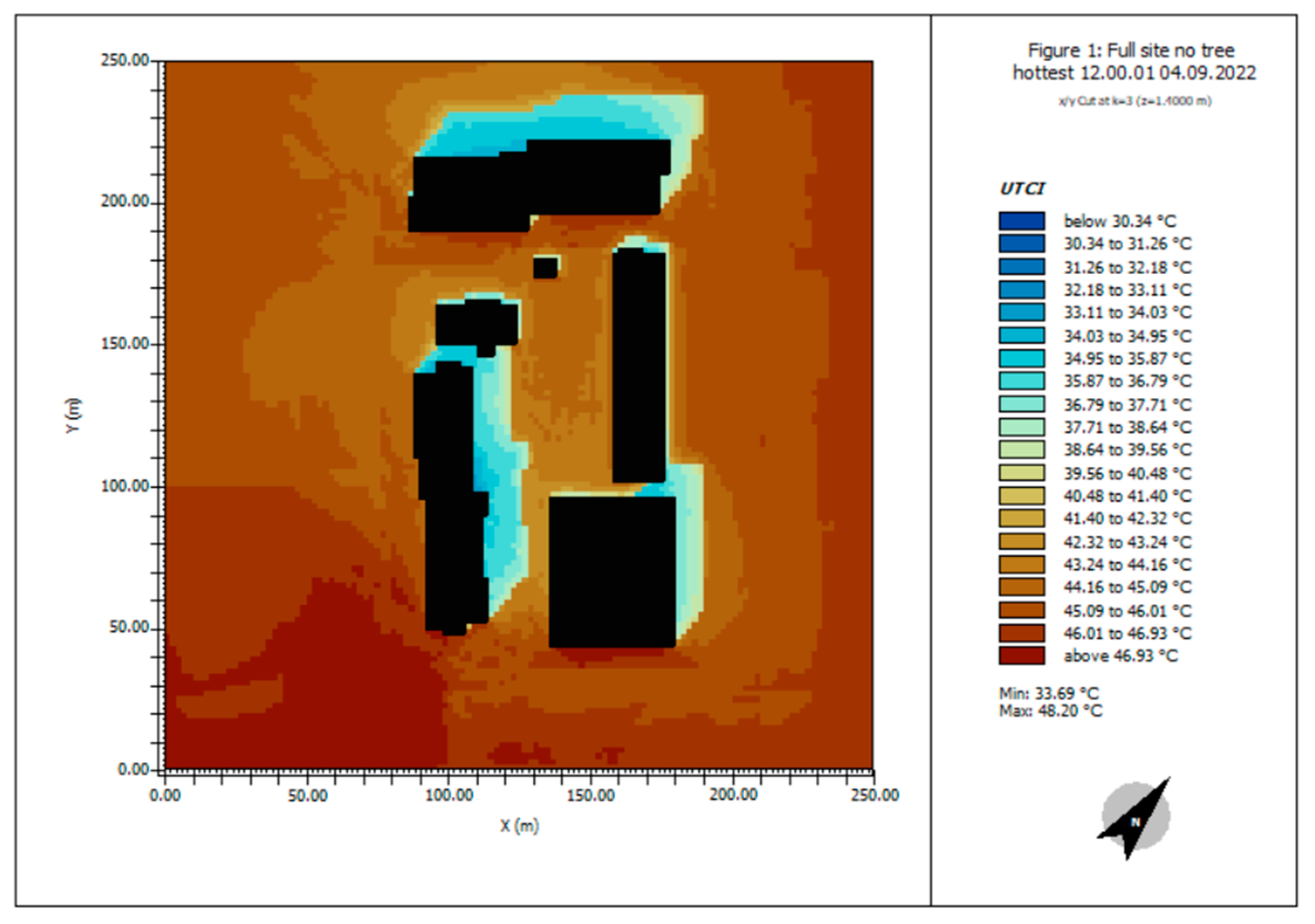
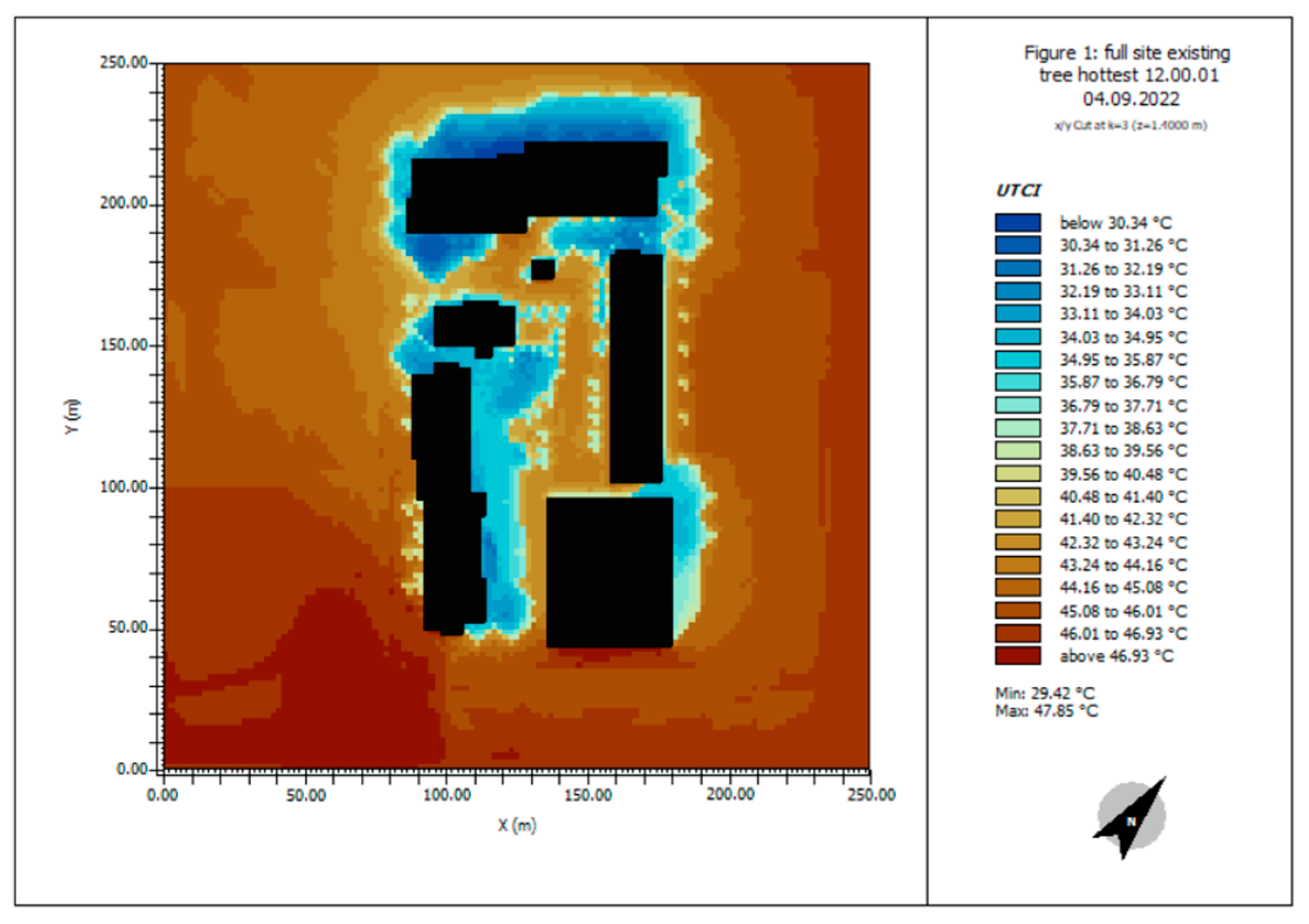

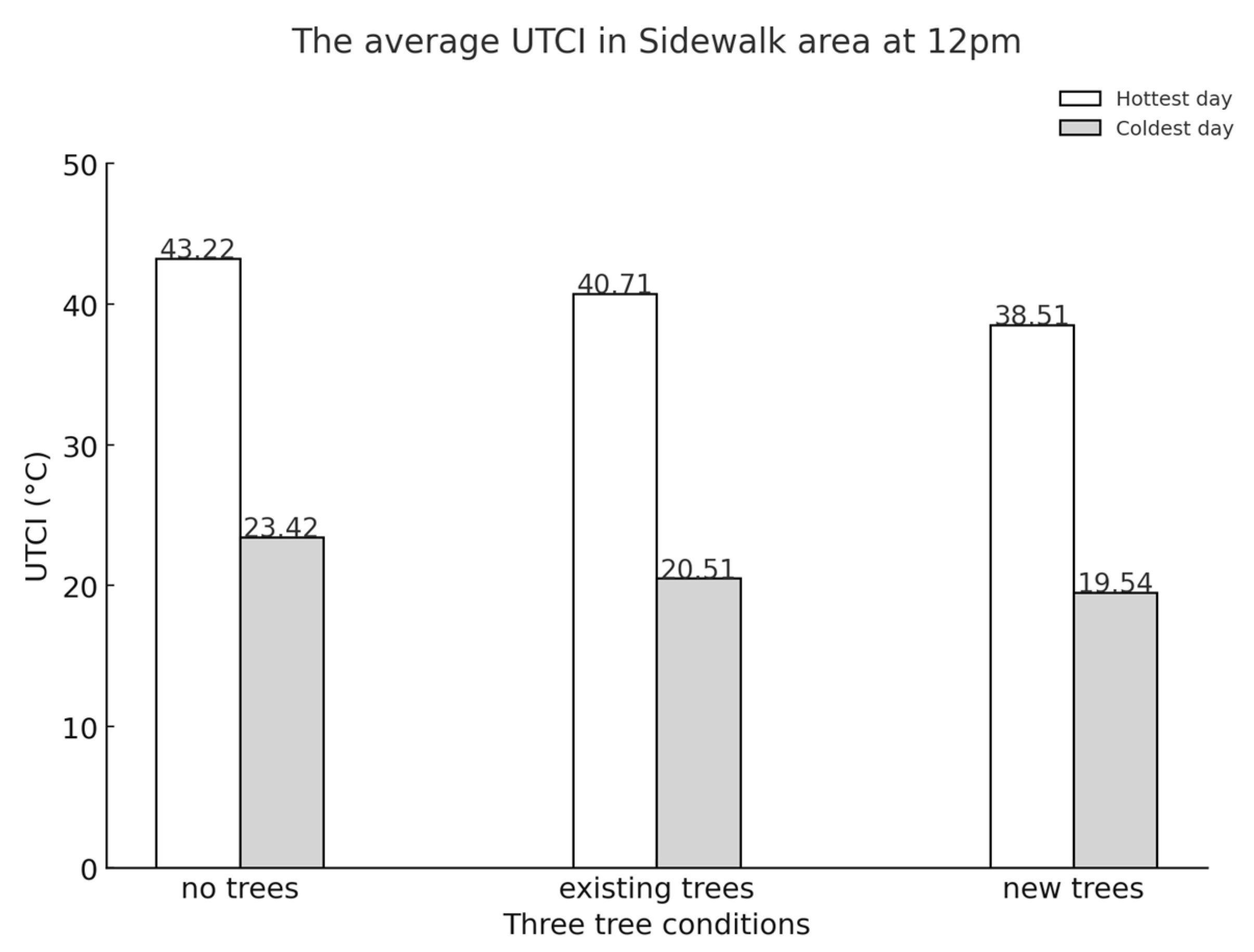
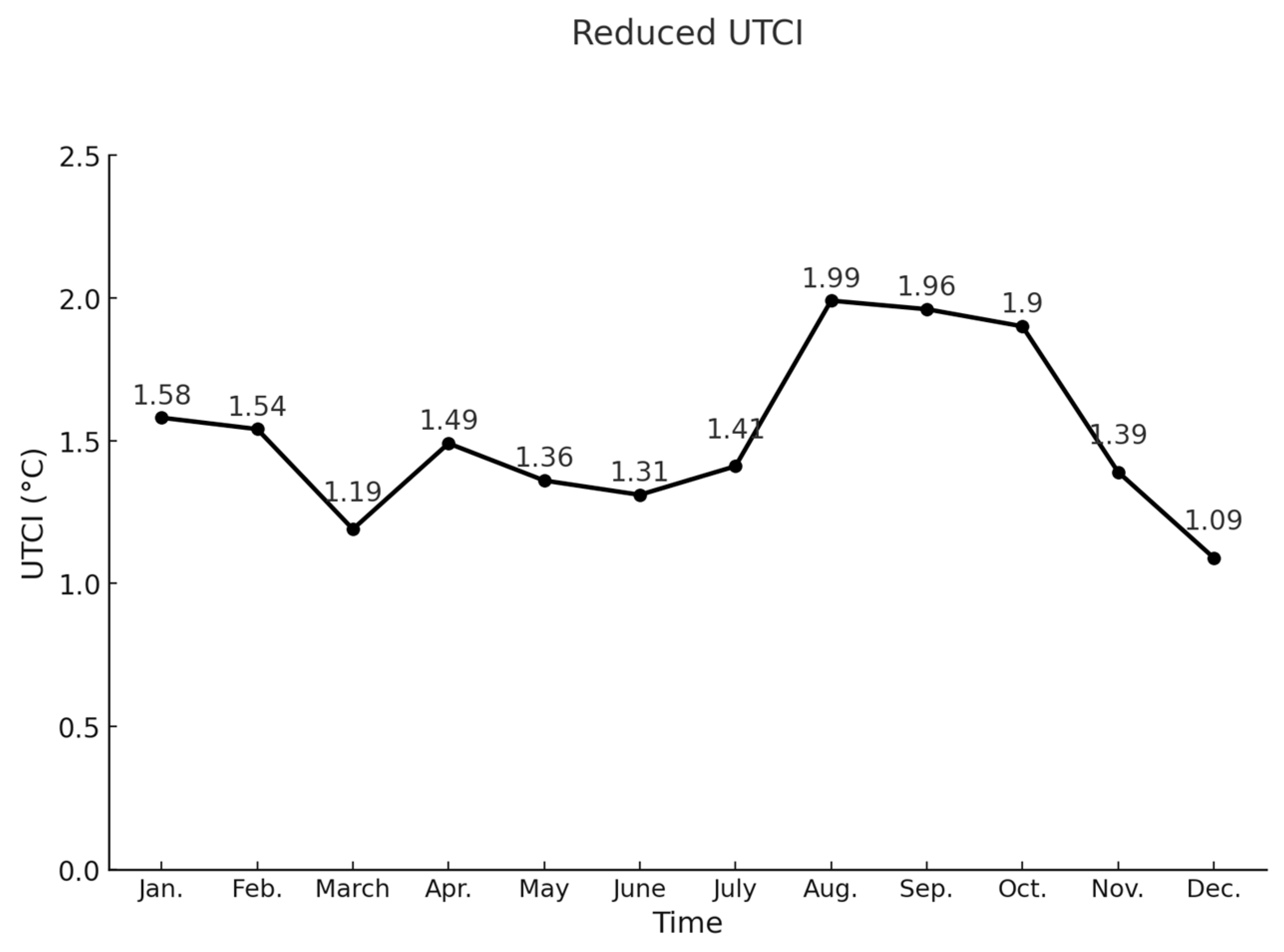
| Canopy Size | Tree Types | Quantity |
|---|---|---|
| Large | Cylindric, small trunk, sparse, 25 m | 8 |
| Spherical, large trunk, dense, 15 m | 2 | |
| Medium | Spherical, medium trunk, dense, 15 m | 18 |
| Spherical, small trunk, dense, 15 m | 5 | |
| Spherical, small trunk, sparse, 15 m | 4 | |
| Small | Spherical, medium trunk, dense, 5 m | 31 |
| Spherical, small trunk, dense, 5 m | 20 | |
| Spherical, medium trunk, sparse, 5 m | 4 |
| UTCI (°C) | Stress Category |
|---|---|
| UTCI > 46 | Extreme heat stress |
| 38 < UTCI ≤ 46 | Very strong heat stress |
| 32 < UTCI ≤ 38 | Strong heat stress |
| 26 < UTCI ≤ 32 | Moderate heat stress |
| 9 < UTCI ≤ 26 | No thermal stress |
| 0 < UTCI ≤ 9 | Slight cold stress |
| −13 < UTCI ≤ 0 | Moderate cold stress |
| −27 < UTCI ≤ −13 | Strong cold stress |
| −40 < UTCI ≤ −27 | Very strong cold stress |
| UTCI ≤ −40 | Extreme cold stress |
| Time | Temperature (Existing Trees) | Temperature (New Trees) | Thermal Stress Level | Reduced UTCI (°C) | Ranking |
|---|---|---|---|---|---|
| Hottest Day | 40.71 | 38.51 | Very Strong Heat Stress | 2.2 | null |
| Coldest Day | 20.51 | 19.54 | No Thermal Stress | 0.97 | null |
| Jan. | 24.81 | 23.23 | No Thermal Stress | 1.58 | 4th |
| Feb. | 25.92 | 24.38 | No Thermal Stress | 1.54 | 5th |
| Mar. | 28.36 | 27.17 | Moderate Heat Stress | 1.19 | 11th |
| Apr. | 30.36 | 28.87 | Moderate Heat Stress | 1.49 | 7th |
| May | 31.68 | 30.32 | Moderate Heat Stress | 1.36 | 9th |
| Jun. | 34.86 | 33.55 | Strong Heat Stress | 1.31 | 10th |
| Jul. | 35.38 | 33.87 | Strong Heat Stress | 1.51 | 6th |
| Aug. | 36.8 | 34.81 | Strong Heat Stress | 1.99 | 1st |
| Sep. | 36.66 | 34.7 | Strong Heat Stress | 1.96 | 2nd |
| Oct. | 31.37 | 29.47 | Moderate Heat Stress | 1.9 | 3rd |
| Nov. | 27.44 | 26.05 | Moderate Heat Stress | 1.39 | 8th |
| Dec. | 25.64 | 24.55 | Moderate Heat Stress | 1.09 | 12th |
Disclaimer/Publisher’s Note: The statements, opinions and data contained in all publications are solely those of the individual author(s) and contributor(s) and not of MDPI and/or the editor(s). MDPI and/or the editor(s) disclaim responsibility for any injury to people or property resulting from any ideas, methods, instructions or products referred to in the content. |
© 2024 by the authors. Licensee MDPI, Basel, Switzerland. This article is an open access article distributed under the terms and conditions of the Creative Commons Attribution (CC BY) license (https://creativecommons.org/licenses/by/4.0/).
Share and Cite
Zhu, Y.; Kensek, K.M. MITIGATING THE URBAN HEAT ISLAND EFFECT: The Thermal Performance of Shade-Tree Planting in Downtown Los Angeles. Sustainability 2024, 16, 8768. https://doi.org/10.3390/su16208768
Zhu Y, Kensek KM. MITIGATING THE URBAN HEAT ISLAND EFFECT: The Thermal Performance of Shade-Tree Planting in Downtown Los Angeles. Sustainability. 2024; 16(20):8768. https://doi.org/10.3390/su16208768
Chicago/Turabian StyleZhu, Yuzhou, and Karen M. Kensek. 2024. "MITIGATING THE URBAN HEAT ISLAND EFFECT: The Thermal Performance of Shade-Tree Planting in Downtown Los Angeles" Sustainability 16, no. 20: 8768. https://doi.org/10.3390/su16208768
APA StyleZhu, Y., & Kensek, K. M. (2024). MITIGATING THE URBAN HEAT ISLAND EFFECT: The Thermal Performance of Shade-Tree Planting in Downtown Los Angeles. Sustainability, 16(20), 8768. https://doi.org/10.3390/su16208768







